HVAC Systems
How to Choose the Best Energy-Efficient Heat Pump

Looking for the top energy-saving heat pump? Hang tight because we’ve got the ultimate manual for you! If you want to save on energy bills and keep your home cozy, keep reading.
We’ll walk you through the ins and outs of heat pumps, help you determine your heating and cooling needs, and evaluate energy efficiency ratings.
Additionally, we’ll provide you with tips for proper installation and maintenance to ensure maximum efficiency.
By the end of this guide, you’ll be equipped with all the knowledge you need to make an informed decision and take your energy savings to the next level.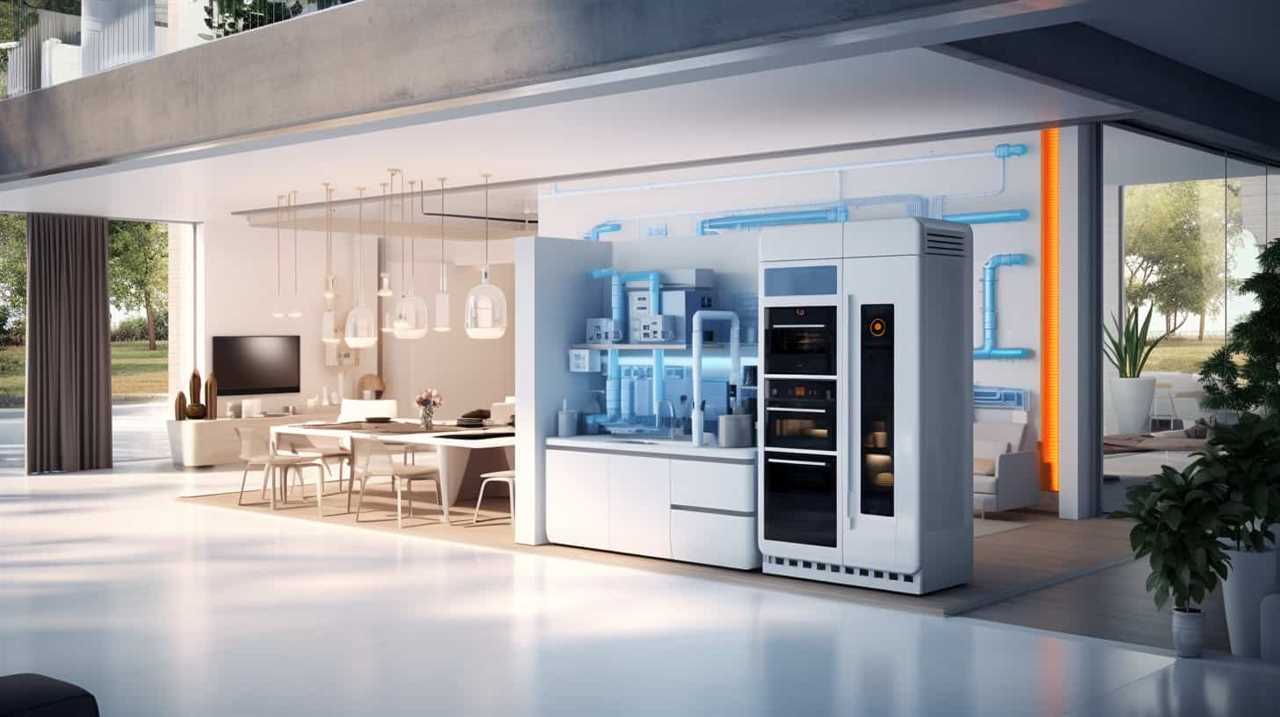
Let’s dive in!
Key Takeaways
- Consider the size and square footage of your space
- Look for higher SEER and HSPF ratings for better energy efficiency
- Proper sizing ensures efficient and effective operation
- Compare different types of heat pumps to find the most suitable option
Understanding Heat Pumps
Let’s start by delving into the basics of heat pumps and how they work. Heat pumps are innovative devices that use the principles of thermodynamics to transfer heat from one place to another. They efficiently move heat from a colder space to a warmer space, making them ideal for both heating and cooling applications.
Understanding heat transfer is crucial in comprehending the functioning of heat pumps. Heat is transferred through a refrigerant cycle, where the refrigerant absorbs heat from the source and releases it in the desired space.
Energy efficient design principles play a pivotal role in enhancing the performance of heat pumps. These principles focus on maximizing efficiency by minimizing energy consumption, optimizing heat transfer, and ensuring proper insulation. By incorporating these design principles, heat pumps deliver exceptional performance while reducing energy consumption, making them an ideal choice for environmentally-conscious individuals.
Determining Your Heating and Cooling Needs
When determining our heating and cooling needs, there are two important factors to consider:
- The size and square footage of our space, and
- The climate and temperature range in our region.
The size and square footage will help us determine the capacity of the heat pump needed to effectively heat and cool our space. Additionally, the climate and temperature range will help us select a heat pump that can efficiently operate in our specific weather conditions.
Size and Square Footage
Selecting the right size and square footage of a heat pump is crucial for determining our heating and cooling needs. When considering the sizing considerations, it’s important to take into account the square footage of the area to be heated or cooled, as well as the climate in which the heat pump will be operating. Here are three key factors to keep in mind when determining the size of the heat pump:
Energy consumption: A properly sized heat pump ensures optimal energy efficiency. An oversized heat pump may consume more energy than necessary, while an undersized one may struggle to meet the heating and cooling demands.

Climate conditions: The climate in your region plays a significant role in determining the size of the heat pump. Colder climates require a larger heat pump to effectively heat the space, while warmer climates may require a smaller one for cooling purposes.
Insulation and air leakage: The level of insulation and the presence of air leaks in your home impact the size of the heat pump. Well-insulated homes with minimal air leakage may require a smaller heat pump, while poorly insulated homes may require a larger one to compensate for heat loss.
Considering these sizing considerations will help ensure that you select the right size and square footage of a heat pump to meet your heating and cooling needs efficiently.
Climate and Temperature Range
To accurately determine our heating and cooling needs, we must consider the climate and temperature range in which the heat pump will operate. The climate and temperature range directly affect the efficiency and performance of the heat pump.
In regions with extreme temperature variations, such as those experiencing climate change, it’s crucial to choose a heat pump that can handle both heating and cooling efficiently. The heat pump should be able to provide sufficient heating during colder months and effective cooling during hotter months.
Furthermore, the energy consumption of the heat pump is influenced by the climate and temperature range. In areas with harsh winters or scorching summers, the heat pump may consume more energy to maintain the desired indoor temperature.
Therefore, it’s essential to select a heat pump that’s designed to operate optimally in the specific climate and temperature range of your region.
Evaluating Energy Efficiency Ratings
Evaluating energy efficiency ratings can help us determine the best heat pump for our needs. When choosing the right heat pump, it’s important to consider the following:
SEER Rating: The Seasonal Energy Efficiency Ratio (SEER) measures the cooling efficiency of the heat pump. Higher SEER ratings indicate greater energy efficiency and lower operating costs.
HSPF Rating: The Heating Seasonal Performance Factor (HSPF) measures the heating efficiency of the heat pump. A higher HSPF rating means better energy efficiency and lower heating costs.
ENERGY STAR Certification: Look for heat pumps that are ENERGY STAR certified. These models have met strict energy efficiency guidelines set by the Environmental Protection Agency (EPA) and can help you save on energy bills.
Sizing Your Heat Pump Correctly
When determining the correct size for our heat pump, we must consider the square footage of our home and the climate in which we live. Sizing accuracy is crucial to ensure that the heat pump operates efficiently and effectively.
A heat pump that’s too small will struggle to heat or cool our home adequately, leading to increased energy consumption and reduced comfort. On the other hand, a heat pump that’s too large will cycle on and off frequently, wasting energy and potentially causing temperature fluctuations.
Comparing Different Types of Heat Pumps
When comparing different types of heat pumps, there are several key points to consider.
First, efficiency and cost play a crucial role in determining the long-term benefits of a heat pump.
Additionally, it’s important to evaluate the performance of different heat pump types in different climates, as this can greatly impact their effectiveness.
Lastly, installation and maintenance requirements should be taken into account to ensure a smooth and hassle-free experience with your heat pump system.
Efficiency and Cost
As we compare different types of heat pumps, it’s important to consider their efficiency and cost.
When evaluating efficiency, it’s crucial to understand the difference between efficiency and effectiveness. Efficiency refers to how well a heat pump converts energy into heat, while effectiveness refers to how well it heats your home.
To determine the efficiency of a heat pump, an energy consumption analysis is necessary. This analysis takes into account factors such as the heat pump’s coefficient of performance (COP) and seasonal energy efficiency ratio (SEER).
Additionally, it’s essential to consider the cost of a heat pump, including the initial installation cost, ongoing maintenance costs, and potential energy savings over time.
Performance in Climates
To accurately compare different types of heat pumps, we need to consider their performance in various climates. A performance analysis of heat pumps in different climates can help determine their climate suitability and overall efficiency.
| Climate | Air-Source Heat Pump | Ground-Source Heat Pump | Hybrid Heat Pump |
|---|---|---|---|
| Mild | Excellent | Excellent | Excellent |
| Moderate | Good | Excellent | Excellent |
| Cold | Good | Good | Excellent |
| Very Cold | Fair | Good | Good |
The table above provides a general overview of how different types of heat pumps perform in different climates. It is important to note that individual performance may vary based on specific models and installation factors. However, this analysis can serve as a starting point for selecting the best heat pump for your climate.
Considering the performance in various climates is crucial when choosing a heat pump that will provide optimal efficiency and comfort. Now that we have discussed performance in different climates, let’s move on to the next section about installation and maintenance.
Installation and Maintenance
For our comparison of different types of heat pumps, we’ll focus on the installation and maintenance aspects.
When considering the installation process, it’s important to look for heat pumps that come with clear instructions and user-friendly features. A heat pump that’s easy to install can save time and ensure a smooth transition to efficient heating and cooling.
In terms of maintenance, warranty coverage plays a crucial role. Look for heat pumps with comprehensive warranties that cover not only the unit itself but also key components like the compressor. This will provide peace of mind and protect your investment in the long run.
Additionally, consider the long-term performance of the heat pump. Choose a model that has a proven track record of reliability and efficiency, as this will minimize the need for frequent repairs and ensure consistent comfort throughout the year.

Exploring Variable-Speed Technology
The article explores the benefits of using variable-speed technology in heat pumps.
Variable speed technology refers to the ability of a heat pump to adjust its speed and capacity based on the heating or cooling needs of a space.
This technology offers several advantages in terms of energy efficiency and comfort.
Firstly, variable speed heat pumps can operate at lower speeds for longer periods of time, resulting in consistent and even temperature distribution throughout a room. This eliminates the need for frequent on/off cycling, reducing energy consumption and utility bills.
Secondly, variable speed heat pumps provide precise control over temperature and humidity levels, ensuring optimal comfort for occupants.
Finally, these heat pumps can automatically adjust their output based on external conditions, such as outdoor temperature, further enhancing energy efficiency.
Considering the SEER and HSPF Ratings
When choosing an energy-efficient heat pump, it’s important to consider the SEER and HSPF ratings.
The SEER rating, or Seasonal Energy Efficiency Ratio, measures the cooling efficiency of the heat pump, while the HSPF rating, or Heating Seasonal Performance Factor, measures its heating efficiency.
These ratings provide a comparison of the heat pump’s efficiency to help you make an informed decision and maximize energy savings in your home.
SEER Vs HSPF
While SEER and HSPF ratings are important factors to consider, we should understand their differences in order to choose the best energy-efficient heat pump.
When comparing efficiency ratings, it’s crucial to know that SEER (Seasonal Energy Efficiency Ratio) measures cooling efficiency, while HSPF (Heating Seasonal Performance Factor) measures heating efficiency.
Here’s what you need to know about SEER vs HSPF:
SEER rating: This rating indicates the cooling efficiency of a heat pump. The higher the SEER rating, the more energy-efficient the heat pump is in cooling mode.
HSPF rating: The HSPF rating measures the heating efficiency of a heat pump. A higher HSPF rating means better energy efficiency in heating mode.
Comparison: When comparing SEER and HSPF ratings, it’s important to consider your climate. If you live in a region with milder winters, a higher SEER rating may be more beneficial. However, in colder climates, a higher HSPF rating becomes more important.
Understanding the differences between SEER and HSPF ratings will help you make an informed decision when choosing an energy-efficient heat pump.

Now, let’s move on to comparing the efficiency of different heat pumps.
Efficiency Comparison
To compare the efficiency of different heat pumps, we should consider the SEER (Seasonal Energy Efficiency Ratio) and HSPF (Heating Seasonal Performance Factor) ratings. These ratings are efficiency standards that help consumers make informed decisions about energy consumption.
The SEER rating measures how efficiently a heat pump cools a space, while the HSPF rating measures its heating efficiency. Higher SEER and HSPF ratings indicate greater energy efficiency.
When comparing heat pumps, it’s important to look for models with higher SEER and HSPF ratings, as they’ll consume less energy and provide cost savings in the long run. By considering these efficiency ratings, consumers can choose the most energy-efficient heat pump that meets their heating and cooling needs.
Impact on Energy Savings
By considering the SEER (Seasonal Energy Efficiency Ratio) and HSPF (Heating Seasonal Performance Factor) ratings, we can assess the impact on energy savings when choosing an energy-efficient heat pump. These ratings indicate the efficiency of the heat pump and directly affect its cost effectiveness.
Here are three key factors to consider:
SEER Rating: The SEER rating measures the cooling efficiency of the heat pump. A higher SEER rating means the heat pump is more energy efficient, resulting in lower energy consumption and higher energy savings.
HSPF Rating: The HSPF rating measures the heating efficiency of the heat pump. Similar to the SEER rating, a higher HSPF rating indicates a more energy-efficient heat pump, leading to reduced energy usage and increased energy savings.

Overall Energy Savings: By choosing a heat pump with high SEER and HSPF ratings, you can significantly impact your energy savings. These energy-efficient models consume less electricity, resulting in lower utility bills and long-term cost effectiveness.
Considering the SEER and HSPF ratings when selecting an energy-efficient heat pump can have a substantial impact on energy savings and cost effectiveness.
Examining the Noise Levels of Heat Pumps
We can assess the noise levels of heat pumps through careful observation and measurement. When choosing a heat pump, it’s important to consider its noise levels, as excessive noise can be disruptive and reduce the overall comfort in your home or office space.
Heat pumps consist of an outdoor unit and an indoor unit, and both can generate noise during operation. The noise levels of a heat pump are typically measured in decibels (dB). Sound insulation plays a crucial role in reducing the noise generated by heat pumps. Advanced heat pumps are designed with sound-insulating materials to minimize noise transmission.
Additionally, some heat pumps have variable-speed compressors, which can reduce noise levels by adjusting the speed of operation based on the heating or cooling needs. By considering the noise levels and sound insulation of a heat pump, you can ensure a quieter and more comfortable environment.
Assessing the Warranty and Maintenance Requirements
When considering the purchase of an energy-efficient heat pump, it’s crucial to assess the warranty and maintenance requirements.
Warranty coverage is of utmost importance as it provides protection against any potential defects or malfunctions.
Additionally, it’s essential to consider the long-term performance expectations and the associated maintenance costs to ensure that the heat pump remains efficient and reliable throughout its lifespan.

Warranty Coverage Importance
Our research indicates that a comprehensive warranty is essential when selecting an energy-efficient heat pump. A good warranty provides peace of mind and protects your investment. Here are the key benefits of warranty coverage:
Extended Protection: A comprehensive warranty extends beyond the standard manufacturer’s warranty, providing coverage for a longer period.
Parts and Labor: A good warranty covers both parts and labor, ensuring that any necessary repairs or replacements are taken care of without incurring additional costs.
Ease of Warranty Claim Process: Look for a warranty that offers a streamlined and hassle-free claims process. This includes quick response times, clear instructions, and efficient resolution of claims.

Having a reliable warranty coverage not only saves you money on potential repairs but also ensures that your heat pump operates at its optimal efficiency for years to come.
Maintenance Cost Considerations
Assessing the warranty and maintenance requirements allows us to determine the potential maintenance costs associated with an energy-efficient heat pump. When considering the maintenance cost analysis, it’s important to carefully review the warranty provided by the manufacturer. A comprehensive warranty can provide peace of mind and potentially save money on unexpected repairs.
Look for energy efficient heat pump options that offer a long-term warranty, covering both parts and labor. Additionally, consider the maintenance requirements outlined by the manufacturer. Some heat pumps may require regular professional maintenance to ensure optimal performance and efficiency.
It’s essential to factor in the potential cost of these maintenance visits when evaluating the overall maintenance cost of an energy-efficient heat pump. By thoroughly assessing the warranty and maintenance requirements, you can make an informed decision and choose a heat pump that offers both energy efficiency and cost-effectiveness.
Long-Term Performance Expectations
We should also consider the long-term performance expectations by evaluating the warranty and maintenance requirements of the heat pump. When assessing the warranty, it’s important to look for a manufacturer that offers a comprehensive coverage for an extended period of time. A longer warranty period indicates the manufacturer’s confidence in the product’s long-term durability. Additionally, pay attention to the specific components that are covered under the warranty, as some may have shorter coverage than others.
Maintenance requirements are equally crucial for ensuring the heat pump’s performance reliability. Look for models that have easy-to-follow maintenance procedures and require minimal upkeep. Regular maintenance, such as cleaning filters and inspecting coils, can help prevent breakdowns and maintain optimal efficiency.
By considering both the warranty and maintenance requirements, you can ensure the long-term performance of your heat pump.
Speaking of long-term performance, let’s now move on to researching brand reputation and customer reviews.
Researching Brand Reputation and Customer Reviews
When researching brand reputation and customer reviews, we can look for information on multiple websites to help us make an informed decision. It’s important to consider the brand reputation of a heat pump manufacturer before making a purchase. A good brand reputation indicates that the company has a history of producing reliable and high-quality products.
Websites such as Consumer Reports and Energy Star provide valuable insights into customer satisfaction and product performance. These websites often feature customer reviews and ratings, allowing us to gauge the overall satisfaction of previous buyers. By analyzing these reviews, we can gain a better understanding of the strengths and weaknesses of different heat pump brands.
This information is crucial in selecting a heat pump that not only meets our energy-efficiency needs but also ensures long-term customer satisfaction.
Factoring in Cost and Energy Savings
To determine the most cost-effective and energy-saving heat pump, we should calculate the potential long-term savings in electricity bills. When factoring in cost and energy savings, consider the following:
Energy Efficiency: Look for heat pumps with high Energy Efficiency Ratio (EER) and Seasonal Energy Efficiency Ratio (SEER) ratings. These ratings indicate the unit’s ability to convert electricity into cooling or heating power efficiently, resulting in lower energy consumption and cost effectiveness.
Cost of Operation: Calculate the estimated annual operating cost by multiplying the unit’s energy consumption with the local electricity rate. Compare this cost with other models to identify the most cost-effective option.
Environmental Impact: Consider the heat pump’s environmental impact, such as its use of eco-friendly refrigerants and adherence to energy efficiency standards. Opting for a heat pump with a lower carbon footprint can contribute to sustainability efforts.
Consulting With a Professional for Expert Advice
For the most accurate and reliable guidance on selecting the best energy-efficient heat pump, we highly recommend consulting with a professional for expert advice.

A professional can provide valuable insights and recommendations based on their knowledge and experience in the field. They can help you navigate through the wide array of options available in the market, ensuring that you choose a heat pump that isn’t only energy-efficient but also cost-effective.
By understanding your specific needs and requirements, a professional can suggest energy-saving strategies that will maximize the efficiency of your heat pump, resulting in long-term savings on your energy bills.
Additionally, they can help you evaluate different cost-effective options and determine the best fit for your budget and goals. By seeking expert advice, you can be confident in making an informed decision that aligns with your energy-saving objectives.
This will set the stage for the next step, which is planning for installation and proper placement of your energy-efficient heat pump.
Planning for Installation and Proper Placement
We should carefully consider the location and orientation of the heat pump, as well as the necessary installation requirements, to ensure optimal performance and energy efficiency. When it comes to installation planning and proper placement, there are a few key factors to keep in mind:
Location: Choose a location that’s easily accessible for maintenance purposes and away from any potential obstructions or sources of heat. This will help prevent any interference with the heat pump’s operation and ensure efficient airflow.
Orientation: Properly orienting the heat pump can significantly impact its performance. It’s recommended to position the unit in a way that maximizes exposure to sunlight while minimizing exposure to wind and shade.
Clearance: Ensure that there’s sufficient space around the heat pump for proper airflow. This includes maintaining a clear distance from walls, fences, and other structures.

By carefully considering these installation planning and proper placement guidelines, we can set the stage for optimal energy efficiency and performance.
Transitioning into the next section, let’s now explore how regular maintenance and upkeep can further maximize the efficiency of our heat pump.
Maximizing Efficiency With Regular Maintenance and Upkeep
As we delve into maximizing efficiency with regular maintenance and upkeep, it’s important to prioritize tasks that can help prolong the lifespan and optimize the performance of our heat pump. By following these energy-saving tips, we can ensure that our heat pump operates at its peak efficiency, reducing energy consumption and saving costs in the long run.
Firstly, cleaning or replacing air filters regularly is crucial to maintain proper airflow and prevent dust buildup.
Secondly, checking and cleaning the outdoor coil can enhance heat transfer and prevent blockage.
Thirdly, inspecting and sealing air leaks in ductwork can minimize energy loss.
Lastly, scheduling professional maintenance annually can address any potential issues and keep the system running smoothly.
Frequently Asked Questions
Can a Heat Pump Be Used for Both Heating and Cooling?
A heat pump can efficiently provide both heating and cooling. It offers numerous benefits, such as energy savings and environmental friendliness. By utilizing innovative technology, a heat pump is an excellent choice for maintaining a comfortable indoor climate year-round.
How Do I Determine the Correct Size of a Heat Pump for My Home?
To determine the correct size of a heat pump for your home, assess the square footage, insulation, and climate conditions. A professional evaluation can help optimize efficiency and ensure optimal heating and cooling performance.
What Factors Should I Consider When Comparing Different Types of Heat Pumps?
When comparing heat pumps, there are several factors to consider. Efficiency is key, as energy-saving heat pumps can significantly reduce your energy consumption. Other factors include size, noise level, and cost.
How Can I Assess the Noise Levels of a Heat Pump Before Purchasing?
Assessing noise levels of heat pump brands before purchasing is crucial. We can determine this by researching manufacturer specifications, reading customer reviews, and consulting with experts. This ensures we choose an energy-efficient heat pump without sacrificing comfort.
What Are Some Key Maintenance Requirements for Heat Pumps to Ensure Optimal Efficiency?
Regular maintenance is essential for optimal efficiency. To ensure your heat pump runs smoothly, clean or replace air filters regularly, keep the outdoor unit clear of debris, and schedule professional inspections and tune-ups.
What Are the Benefits of Using an Eco-Friendly Heat Pump HVAC System?
The use of eco-friendly heat pump hvac systems provides numerous benefits. These systems utilize renewable energy sources like the sun, air, or ground to efficiently heat or cool a space. This reduces carbon emissions, saves energy, and lowers utility bills. Additionally, eco-friendly heat pump HVAC systems provide improved indoor air quality and greater comfort, making them a sustainable and reliable choice for heating and cooling needs.
Conclusion
In conclusion, choosing the best energy-efficient heat pump requires careful consideration of several factors.
These factors include heating and cooling needs, energy efficiency ratings, heat pump size, types of heat pumps, cost and energy savings, professional advice, installation planning, and regular maintenance.
By following these guidelines, you can maximize the efficiency of your heat pump and enjoy the benefits of lower energy consumption and cost savings.
HVAC Systems
Your Guide to Picking the Perfect Heat Pump

Looking for the perfect heat pump for your home? Look no further!
In our comprehensive guide, we’ve got you covered with all the information you need. We’ll walk you through the factors to consider, explain efficiency ratings, help you size your heat pump correctly, and compare different types.
We’ll even delve into energy efficiency, climate considerations, additional features, installation requirements, and maintenance tips.
Get ready to make an informed decision with our ultimate heat pump guide!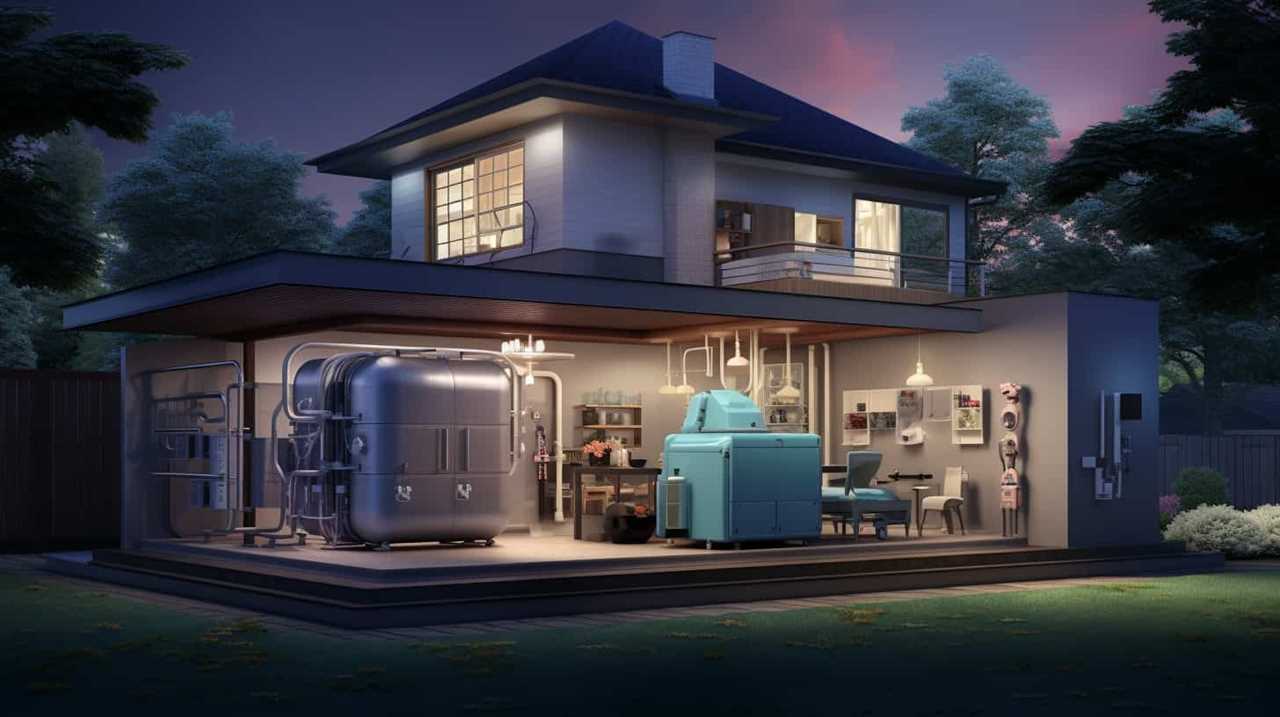
Key Takeaways
- Sizing considerations are crucial when choosing a heat pump, as oversized or undersized units can lead to inefficient operation and increased energy consumption.
- Heat pump efficiency ratings, such as COP and HSPF, should be considered to ensure optimal performance and energy savings.
- Proper installation and maintenance of a heat pump can optimize its efficiency and performance.
- Different types of heat pumps, such as ASHP, GSHP, WSHP, Hybrid Heat Pumps, and Ductless Mini-Split Heat Pumps, offer various benefits and are suitable for different situations.
Factors to Consider When Choosing a Heat Pump
When we’re choosing a heat pump, there are several factors that we need to consider.
Sizing considerations play a crucial role in selecting the right heat pump for your space. It’s important to accurately determine the size of your home or the area you want to heat and cool. Oversized heat pumps can result in inefficient operation and increased energy consumption, while undersized ones may struggle to meet your heating and cooling needs.
Additionally, installation requirements must be taken into account. Heat pumps require proper installation to ensure optimal performance and longevity. Factors such as the location, accessibility, and electrical requirements of the installation site should be considered.
Consulting with a professional HVAC technician can help you determine the appropriate sizing and installation requirements for your heat pump.
Understanding Heat Pump Efficiency Ratings
To fully understand heat pump efficiency ratings, we should examine the different factors that contribute to a heat pump’s overall efficiency. Here are some key points to consider:
-
Heat pump technology advancements: Over the years, heat pump technology has improved significantly, resulting in more efficient systems that can provide better performance and energy savings.
-
Coefficient of Performance (COP) rating: COP measures the ratio of heat output to the electricity input. A higher COP rating indicates greater efficiency.
-
Heating Seasonal Performance Factor (HSPF) rating: HSPF measures a heat pump’s efficiency over an entire heating season. A higher HSPF rating means better energy efficiency.

-
Energy Star certification: Look for heat pumps with the Energy Star label, as they meet strict efficiency guidelines set by the Environmental Protection Agency.
-
Proper installation and maintenance: Ensuring your heat pump is installed correctly and regularly maintained can optimize its efficiency and performance.
Understanding these efficiency ratings will help you make an informed decision when choosing a heat pump that suits your needs.
Now let’s move on to the next section about sizing your heat pump for optimal performance.
Sizing Your Heat Pump for Optimal Performance
We recommend accurately sizing your heat pump for optimal performance by consulting with a professional and considering factors such as the size of your space and climate conditions.
Proper heat pump sizing is crucial as it directly affects the performance and efficiency of the system. If the heat pump is too small for your space, it will struggle to adequately heat or cool your home, resulting in reduced comfort and higher energy bills. On the other hand, if the heat pump is oversized, it will cycle on and off frequently, leading to increased wear and tear and decreased energy efficiency.
A professional can perform a heat load calculation to determine the appropriate size of heat pump for your specific needs, taking into account factors such as insulation levels, window efficiency, and outdoor climate conditions.
Comparing Different Types of Heat Pumps
Let’s compare the various types of heat pumps available to help you make an informed decision. When it comes to heat pump efficiency, there are a few options to consider:
-
Air Source Heat Pumps (ASHP): These pumps extract heat from the outdoor air and transfer it indoors. They’re more affordable upfront but may be less efficient in colder climates.
-
Ground Source Heat Pumps (GSHP): These pumps use the stable temperature of the ground to provide heating and cooling. They’re highly efficient but can be more expensive to install.
-
Water Source Heat Pumps (WSHP): These pumps utilize water as a heat source or sink. They’re efficient but require access to a water source like a lake or pond.
-
Hybrid Heat Pumps: These pumps combine the benefits of an ASHP and a gas furnace. They’re cost-effective and provide efficient heating and cooling.

-
Ductless Mini-Split Heat Pumps: These pumps are ideal for homes without ductwork. They offer individual room control and can be highly efficient.
Consider both the heat pump efficiency and cost when choosing the right type for your home.
Evaluating the Energy Efficiency of Heat Pumps
When evaluating the energy efficiency of heat pumps, there are three key points to consider: the energy-saving benefits, the environmental impact, and the cost-effectiveness.
Heat pumps are known for their ability to save energy by transferring heat from one area to another, rather than generating it. This not only reduces electricity consumption but also lowers utility bills.

Additionally, heat pumps are environmentally friendly as they produce fewer greenhouse gas emissions compared to traditional heating systems.
Lastly, although heat pumps may have a higher upfront cost, their long-term savings and energy efficiency make them a cost-effective choice for homeowners.
Energy-Saving Benefits of Heat Pumps
To accurately assess the energy efficiency of heat pumps, it’s important to evaluate their annual energy performance. By understanding the energy-saving benefits of heat pumps, you can make an informed decision when choosing the perfect heat pump for your needs.
Here are five key benefits to consider:
-
Cost savings: Heat pumps are highly efficient, resulting in lower energy bills compared to traditional heating and cooling systems.
-
Environmental impact: Heat pumps reduce greenhouse gas emissions and help mitigate climate change.
-
Versatility: Heat pumps can provide both heating and cooling, making them a versatile solution for year-round comfort.
-
Long lifespan: With proper maintenance, heat pumps can last up to 20 years, providing long-term energy savings.

-
Incentives and rebates: Many utility companies and government programs offer incentives and rebates to encourage heat pump installation, making them an even more attractive option.
Environmental Impact of Heat Pumps
We can assess the environmental impact of heat pumps by evaluating their energy efficiency and considering their contribution to reducing greenhouse gas emissions.
Heat pumps are known for their ability to transfer heat from one location to another, rather than generating heat directly. This results in significantly lower energy consumption compared to traditional heating and cooling systems.
By using a heat pump, homeowners can reduce their carbon footprint and contribute to environmental sustainability. Heat pumps are designed to maximize efficiency, with advanced technologies such as variable speed compressors and smart controls. These features allow the heat pump to adapt to changing conditions and operate at optimal levels, further reducing energy consumption and greenhouse gas emissions.
When choosing a heat pump, it’s important to consider its energy efficiency rating and look for models that are ENERGY STAR certified, as they meet strict energy efficiency guidelines.
Cost-Effectiveness of Heat Pumps
By evaluating the energy efficiency of heat pumps and considering their cost-effectiveness, we can determine the best option for homeowners. When it comes to choosing a heat pump, it’s important to consider the long-term savings and cost-saving benefits.
Here are five key factors to keep in mind:
-
Energy Efficiency: Heat pumps with higher energy efficiency ratings can save homeowners significant amounts of money on their energy bills.

-
Maintenance Costs: It’s essential to consider the potential maintenance costs associated with different heat pump models.
-
Installation Expenses: The initial cost of installing a heat pump can vary depending on factors such as system size and complexity.
-
Rebates and Incentives: Many utility companies and government entities offer rebates and incentives for homeowners who choose energy-efficient heat pumps.
-
Lifespan: Heat pumps with longer lifespans can provide more cost savings over time, as they require fewer replacements or repairs.

Selecting the Right Heat Pump for Your Climate
In our guide to picking the perfect heat pump, let’s now delve into selecting the right heat pump for your climate. The climate in which you live plays a crucial role in determining the type of heat pump that will work best for you. To help you make an informed decision, consider the following factors: temperature range, humidity levels, and seasonal variations.
| Climate Type | Temperature Range | Humidity Levels | Seasonal Variations |
|---|---|---|---|
| Cold Climate | Below freezing to 20°F | Low | Extreme temperature swings |
| Moderate Climate | 20°F to 50°F | Moderate | Moderate temperature changes |
| Warm Climate | 50°F and above | High | Minimal temperature fluctuations |
Exploring Additional Features and Options
When choosing a heat pump, it’s important to consider the energy efficiency ratings, as these will determine the performance and cost savings of the unit.
Additionally, noise level considerations are crucial, especially if the heat pump will be installed in a bedroom or living area.
Lastly, it’s worth checking if the heat pump is compatible with smart thermostats, as this allows for easy temperature control and energy management.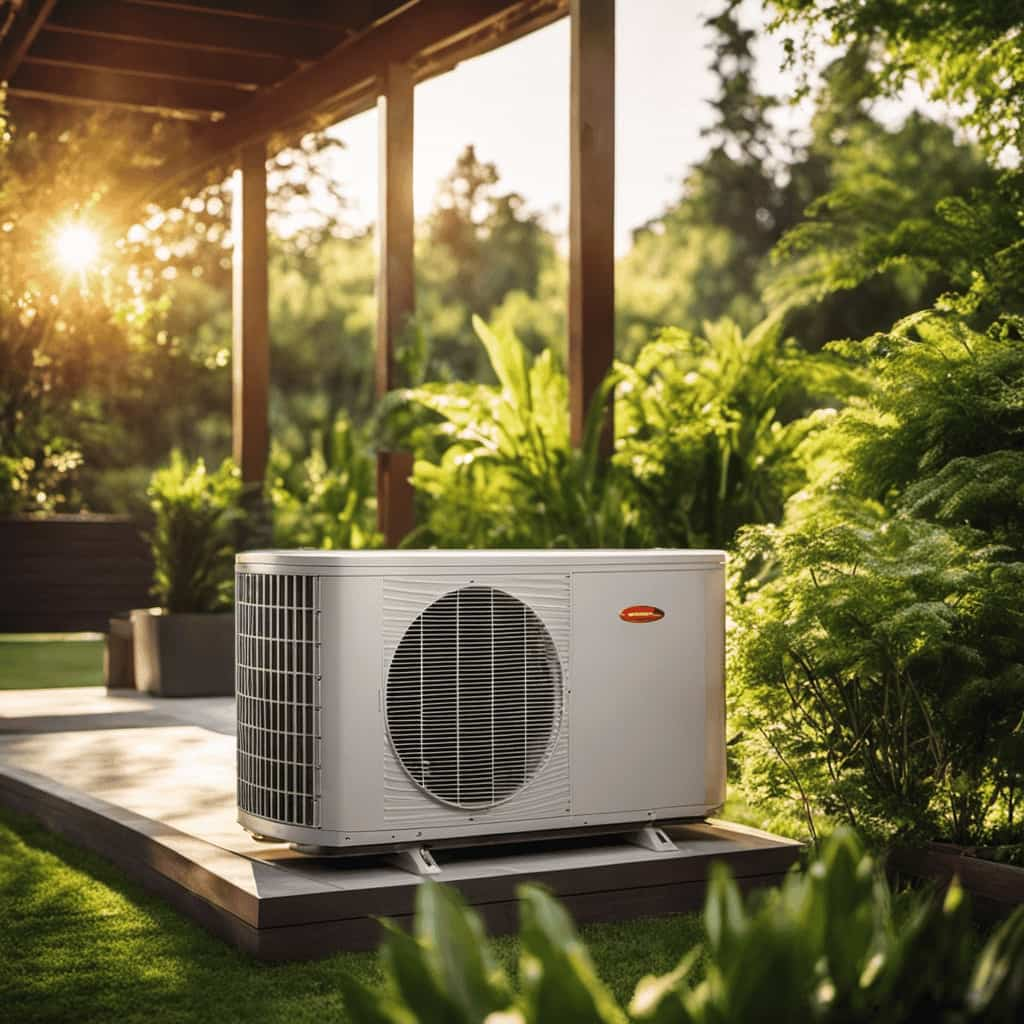
Energy Efficiency Ratings
We recommend considering the Seasonal Energy Efficiency Ratio (SEER) and Heating Seasonal Performance Factor (HSPF) ratings when exploring additional features and options for energy-efficient heat pumps. These ratings provide valuable information regarding the energy efficiency and performance of the heat pump.
Here are five key advantages of energy-efficient heat pumps:
-
Lower Energy Costs: Energy-efficient heat pumps consume less electricity, resulting in lower energy bills.
-
Environmental Benefits: By reducing energy consumption, these heat pumps contribute to a greener and more sustainable future.
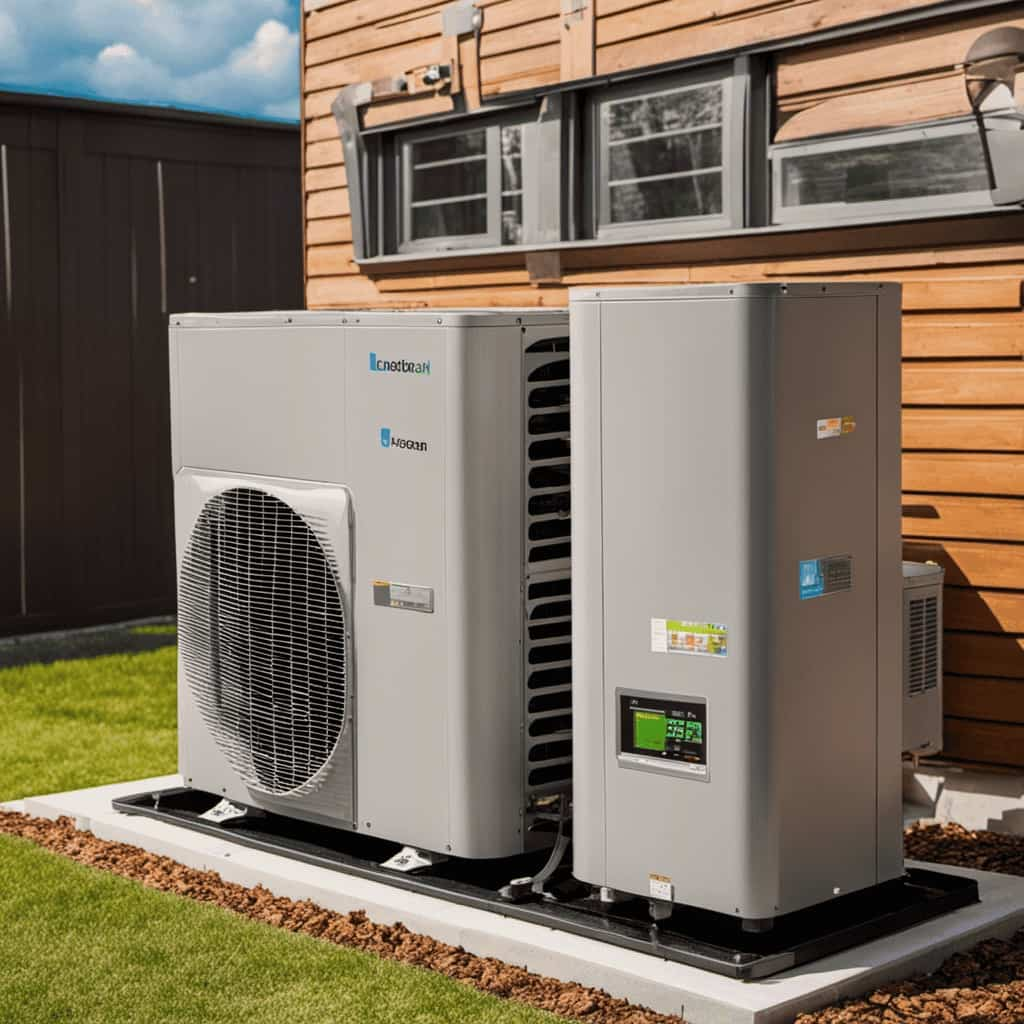
-
Enhanced Comfort: Energy-efficient heat pumps provide consistent heating and cooling, ensuring optimal comfort throughout the year.
-
Longer Lifespan: These heat pumps are built with high-quality components, offering increased durability and longevity.
-
Reduced Maintenance: Energy-efficient heat pumps often require less maintenance, resulting in fewer repair expenses.
Considering these advantages, investing in an energy-efficient heat pump is a wise choice that can provide long-term benefits for both your comfort and your wallet.
Noise Level Considerations
To ensure a quiet and peaceful environment, we recommend considering the noise level of heat pumps when exploring additional features and options. A heat pump with quiet operation is crucial, especially if the unit will be installed near bedrooms, living areas, or other noise-sensitive areas.
When comparing heat pumps, it’s important to look for models that have a low decibel rating. A decibel rating of 50 or less is generally considered quiet.
Additionally, if noise is a concern, there are soundproofing options available. These options include adding sound barriers or insulation around the heat pump, or installing the unit on a soundproofing pad.
Smart Thermostat Compatibility
The smart thermostat compatibility of a heat pump offers additional features and options that we can explore.
With smart home integration, you can control your heat pump remotely using your smartphone or voice commands. This allows for convenient temperature adjustments and energy savings even when you’re not at home.
The programming flexibility of a smart thermostat is another advantage. You can set customized schedules to match your lifestyle and preferences, ensuring optimal comfort and efficiency.
Additionally, smart thermostats often come with advanced features like learning capabilities that adapt to your behavior and weather forecasts that help optimize energy usage.
With smart thermostat compatibility, you can take your heat pump to the next level, making it a valuable addition to your smart home setup.
Assessing Installation Requirements and Costs
Installing a heat pump typically requires 1-3 days of labor, and costs can range from $3,000 to $10,000. The installation process involves several steps to ensure proper functioning and efficiency. First, the location for the heat pump needs to be determined, taking into account factors such as noise levels and access to outdoor air. Next, the necessary electrical and plumbing work needs to be completed. This includes wiring the heat pump to the electrical panel and connecting it to the existing ductwork or installing new ducts if needed. Additionally, budget considerations play a crucial role in the installation process. It’s important to allocate funds for not only the equipment, but also for any necessary upgrades or modifications to the home’s infrastructure. To help you plan your budget, here’s a table outlining the potential costs involved in heat pump installation:
| Installation Cost Factors | Estimated Cost Range |
|---|---|
| Heat Pump Equipment | $1,500 – $6,000 |
| Electrical Work | $500 – $2,000 |
| Plumbing Work | $500 – $2,000 |
| Ductwork Modifications | $500 – $3,000 |
| Permits and Inspections | $200 – $1,000 |
Maintenance Tips for Extending the Lifespan of Your Heat Pump
We can maximize the lifespan of our heat pump by following these maintenance tips:
- Regularly clean or replace air filters to ensure proper airflow and prevent build-up of dirt and debris.
- Keep the outdoor unit clear of leaves, grass, and other obstructions to maintain optimal performance.
- Schedule annual professional maintenance to check for any potential issues and ensure all components are functioning correctly.
- Monitor refrigerant levels and recharge if needed to prevent strain on the system.
- Protect the unit during extreme weather conditions by covering it with a waterproof cover or shelter.
By implementing these maintenance tips, we can extend the lifespan of our heat pump and ensure it operates efficiently for years to come.
Regular upkeep and preventive measures won’t only save us from costly repairs but also help us maintain a comfortable indoor environment throughout the year.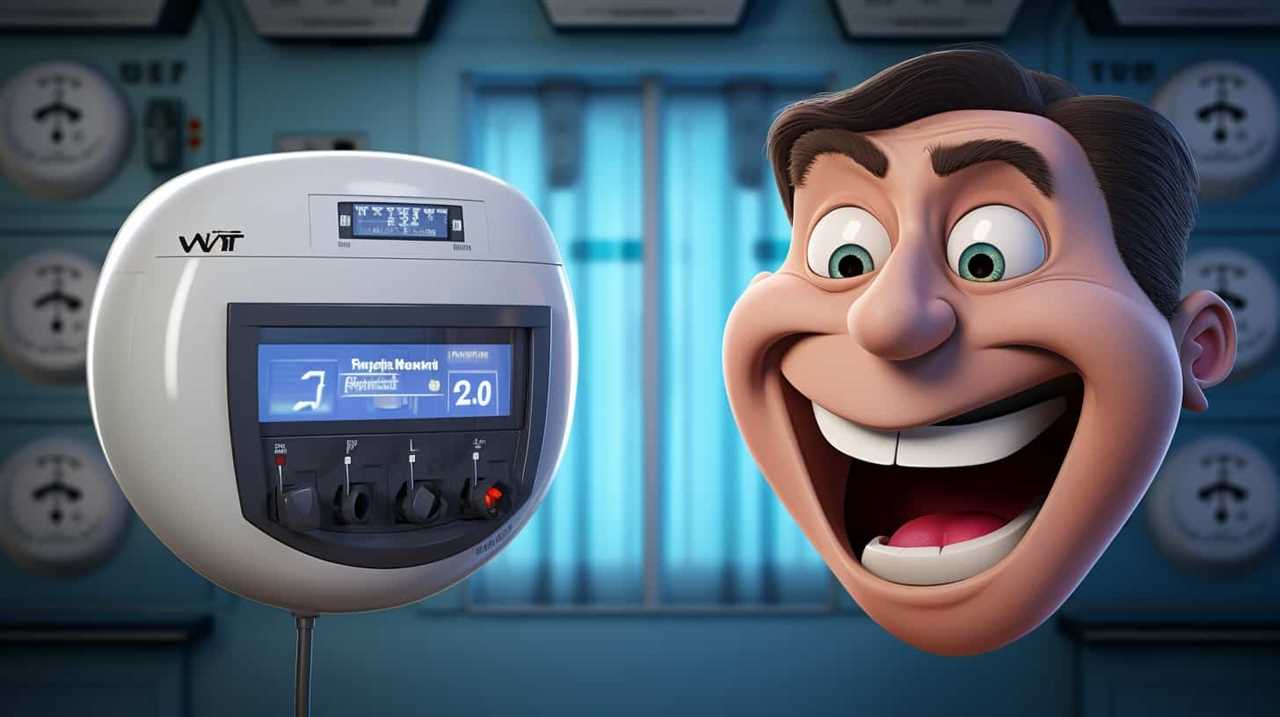
Frequently Asked Questions
Can I Install a Heat Pump Myself, or Do I Need to Hire a Professional?
We can install a heat pump ourselves, but it is recommended to hire a professional for a safer and more efficient installation. DIY installation requires technical knowledge and can void warranties if done improperly.
Are There Any Tax Credits or Incentives Available for Purchasing a Heat Pump?
Tax credits and financial incentives are available for purchasing heat pumps, incentivizing their energy efficiency. While installation costs vary, both DIY and professional installation options exist. Heat pumps have a long lifespan, but eventually require replacement. They provide heating and cooling functionality while minimizing energy consumption and operating costs.
How Long Does a Typical Heat Pump Last Before Needing to Be Replaced?
Heat pumps typically last around 15-20 years before needing replacement. Regular heat pump maintenance, such as cleaning and regular inspections, can help extend its lifespan. Signs of a failing heat pump include reduced heating or cooling performance and increased energy consumption.
Can a Heat Pump Be Used to Both Heat and Cool My Home?
Yes, a heat pump can be used to both heat and cool your home. It offers the benefits of efficient heating and cooling, reducing energy costs. Regular heat pump maintenance tips can ensure optimal performance and longevity.
What Is the Average Cost of Operating a Heat Pump Compared to Other Heating and Cooling Systems?
The average operating cost of a heat pump compared to other heating and cooling systems depends on factors such as energy efficiency. It is important to consider these factors when evaluating the cost effectiveness of different systems.
Conclusion
In conclusion, when it comes to picking the perfect heat pump, it’s crucial to consider factors like efficiency ratings, sizing, and climate suitability.
By evaluating different types, energy efficiency, and additional features, you can make an informed decision.
Remember to assess installation requirements and maintenance tips to ensure optimal performance and extend the lifespan of your heat pump.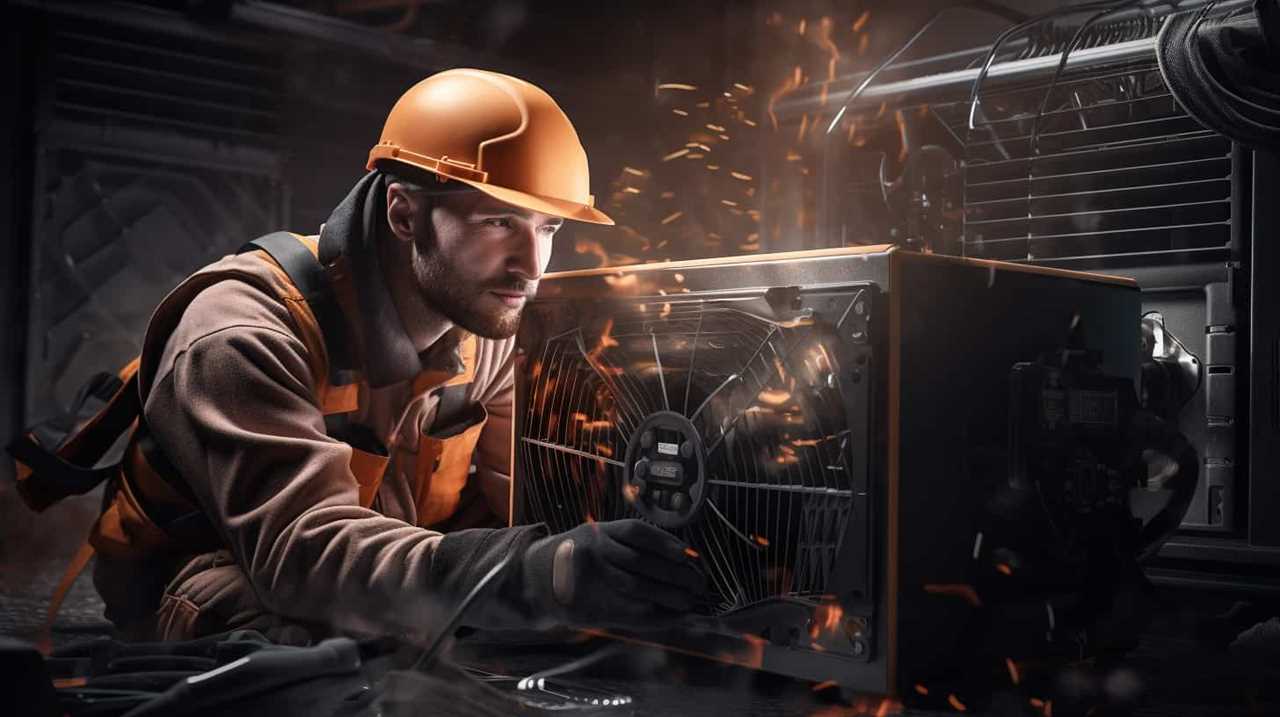
So, start your search and select a system that seamlessly suits your needs, providing powerful and efficient heating or cooling all year round.
HVAC Systems
Zero-Cost Guide: Selecting the Perfect HVAC Heat Pump

We understand your worry – selecting the perfect HVAC heat pump can be daunting. But fear not! Our complimentary guide is here to help you out.
In this article, we will walk you through the key considerations, efficiency ratings, sizing, types, features, and installation and maintenance requirements.
With our detailed and informative approach, you’ll be equipped with the knowledge you need to make an informed decision.
Say goodbye to confusion and hello to the perfect heat pump for your HVAC system!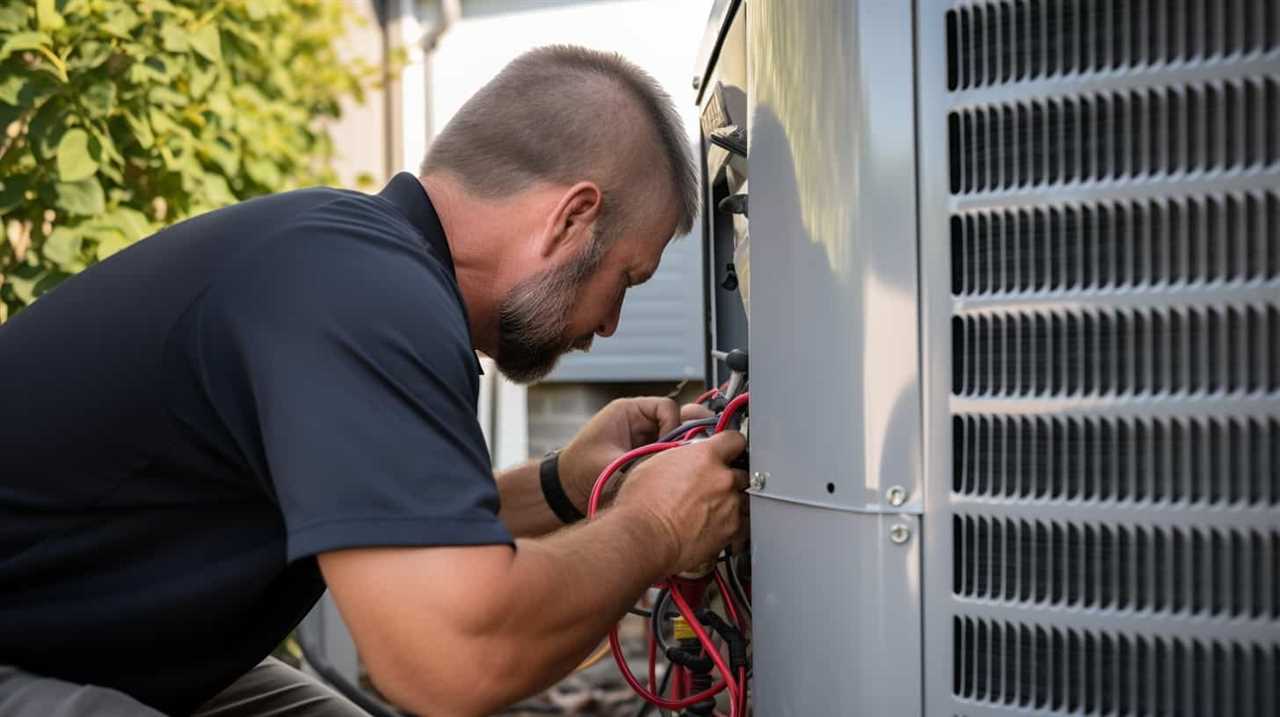
Key Takeaways
- Consider the heat pump brand (e.g. Carrier, Trane, Lennox)
- Look for cost-effectiveness and long-term energy savings
- Ensure reliability and durability of the heat pump
- Consider compatibility with your home’s HVAC system
Key Considerations for Choosing the Right Heat Pump
When selecting the right heat pump, we must consider several key factors. One of the most important considerations is the heat pump brand. It’s crucial to choose a reputable brand that offers reliable and durable products. Some well-known heat pump brands include Carrier, Trane, and Lennox.
Another factor to consider is cost-effectiveness. It’s essential to find a heat pump that not only fits your budget but also provides long-term energy savings. Many brands offer cost-effective options that are energy-efficient and can help reduce your utility bills.
By choosing the right heat pump brand and considering cost-effective options, you can ensure that you’re making a wise investment in your home’s HVAC system.
Now, let’s delve into understanding efficiency ratings and energy savings.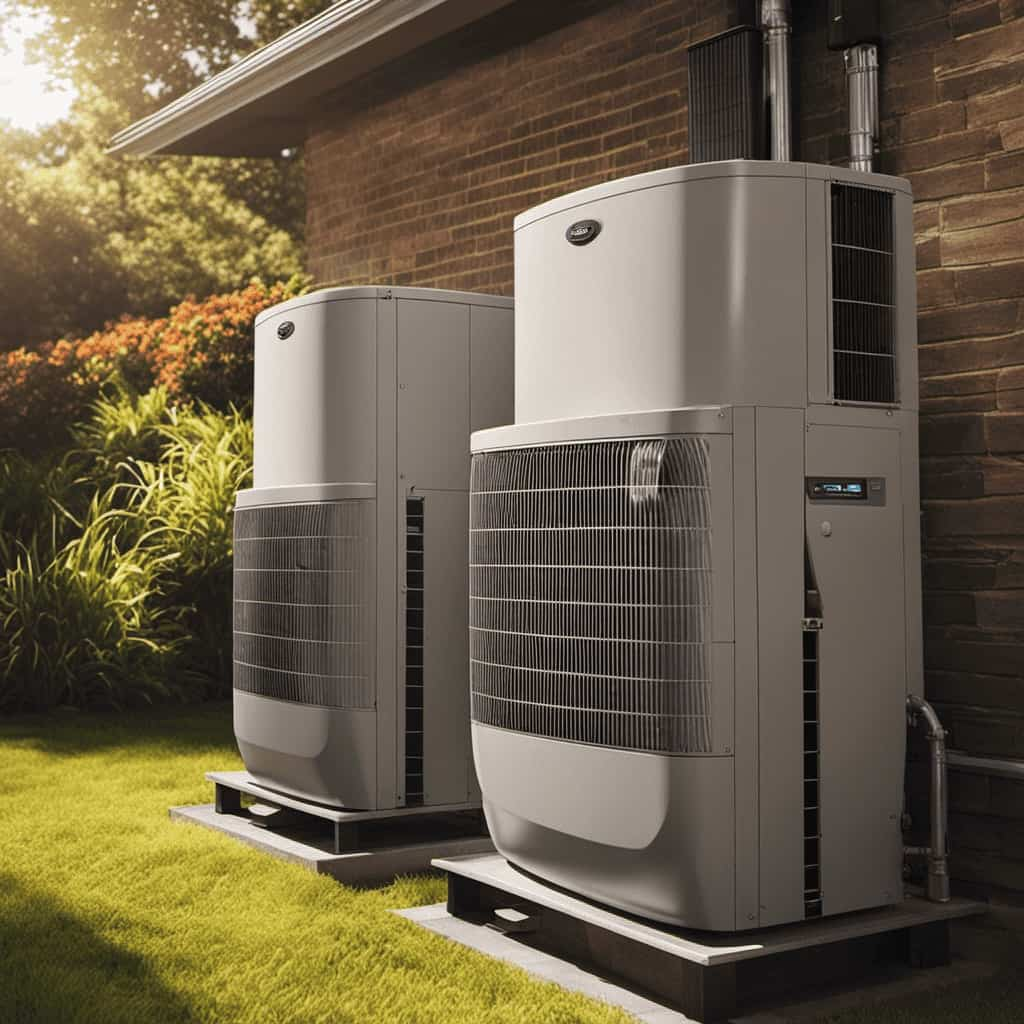
Understanding Efficiency Ratings and Energy Savings
To understand efficiency ratings and energy savings, we must consider the different factors that contribute to a heat pump’s performance. Efficiency ratings are a measure of how effectively a heat pump converts energy into useful heating or cooling. The higher the rating, the more efficient the heat pump is, resulting in lower energy consumption and cost savings.
Energy savings can be achieved by selecting a heat pump with a high Seasonal Energy Efficiency Ratio (SEER) and Heating Seasonal Performance Factor (HSPF). Additionally, features such as variable-speed motors and smart thermostats can further improve indoor air quality and maximize comfort levels.
By prioritizing efficiency ratings and energy savings, homeowners can’t only reduce their carbon footprint but also enjoy a more comfortable and cost-effective HVAC system.
Now, let’s move on to the next section and discuss how to properly size your heat pump to match your HVAC system.

Sizing Your Heat Pump: Matching It to Your HVAC System
In order to properly size our heat pump and ensure it matches our HVAC system, we need to consider the specific heating and cooling requirements of our home.
Heat pump capacity is a crucial factor to consider. It refers to the amount of heating or cooling that a heat pump can provide. To determine the correct capacity, we must calculate the heating and cooling load of our home. This involves considering factors such as the size of our home, insulation levels, number of windows, and local climate.
Additionally, heat pump efficiency is another important consideration. It determines how effectively the heat pump converts energy into heating or cooling. Higher efficiency heat pumps can provide cost savings in the long run.
Exploring Different Heat Pump Types and Features
We will now explore the various types and features of heat pumps to help us make an informed decision.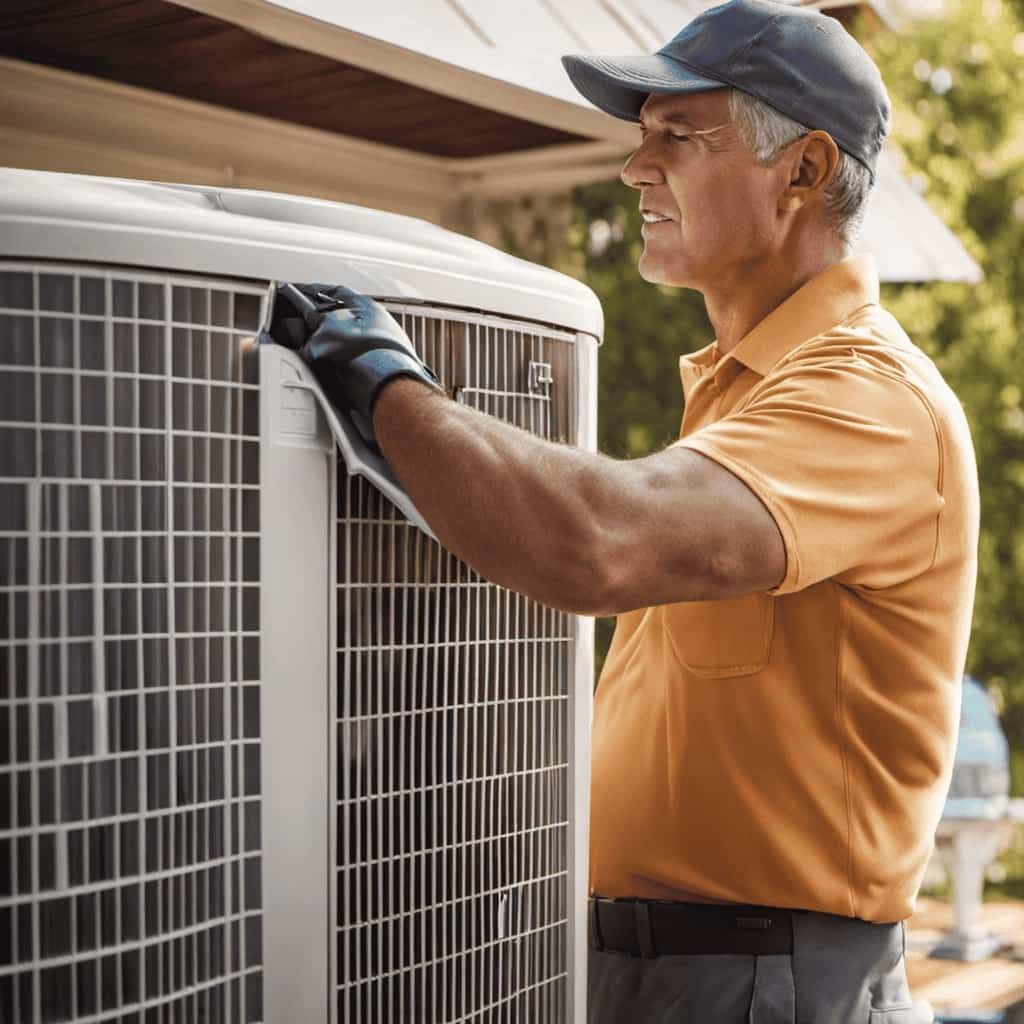
When comparing heat pump prices, it’s important to consider the initial cost as well as the long-term savings on energy bills.
Some innovative heat pump technologies to consider include:
Variable-speed compressors: These heat pumps adjust their speed based on the heating or cooling needs of your home, resulting in increased energy efficiency and improved comfort.
Two-stage heat pumps: These heat pumps have two different operating speeds, allowing them to run at a lower speed for milder weather and a higher speed for extreme temperatures.

Geothermal heat pumps: These heat pumps utilize the stable temperature of the ground to provide efficient heating and cooling, making them an environmentally friendly option.
Exploring these different types and features will help you choose the heat pump that best fits your needs and budget.
Evaluating Installation and Maintenance Requirements
When considering a heat pump, it’s important for us to evaluate the installation and maintenance requirements. Evaluating performance and cost comparison are crucial steps in this process.
Firstly, evaluating the performance of a heat pump involves looking at its heating and cooling capacity, energy efficiency, and noise levels. It’s important to choose a heat pump that meets the specific heating and cooling needs of your space while also being energy efficient and quiet.
Secondly, cost comparison is essential in determining the long-term affordability of a heat pump. This involves considering the initial installation costs, as well as the ongoing maintenance and energy costs. It’s important to choose a heat pump that provides the best value for your budget, taking into account both the upfront and long-term expenses.
Frequently Asked Questions
Can I Install a Heat Pump Myself, or Do I Need to Hire a Professional for Installation?
Installing a heat pump yourself may save money initially, but it comes with risks. Hiring a professional ensures proper installation, preventing damage and potential safety hazards. They have the expertise and knowledge to handle the job efficiently and effectively.
Are Heat Pumps Suitable for All Climates, or Are There Certain Regions Where They Are More Effective?
Heat pump efficiency is influenced by climate. While heat pumps work in all climates, they are more effective in moderate climates. Extreme cold or hot regions can reduce their performance, making additional heating or cooling sources necessary.
How Can I Determine the Right Size of Heat Pump for My Home?
Determining the right size of a heat pump for our home involves calculating the heat pump capacity. It’s essential to consider factors such as square footage, insulation, and climate to ensure optimal performance and energy efficiency.
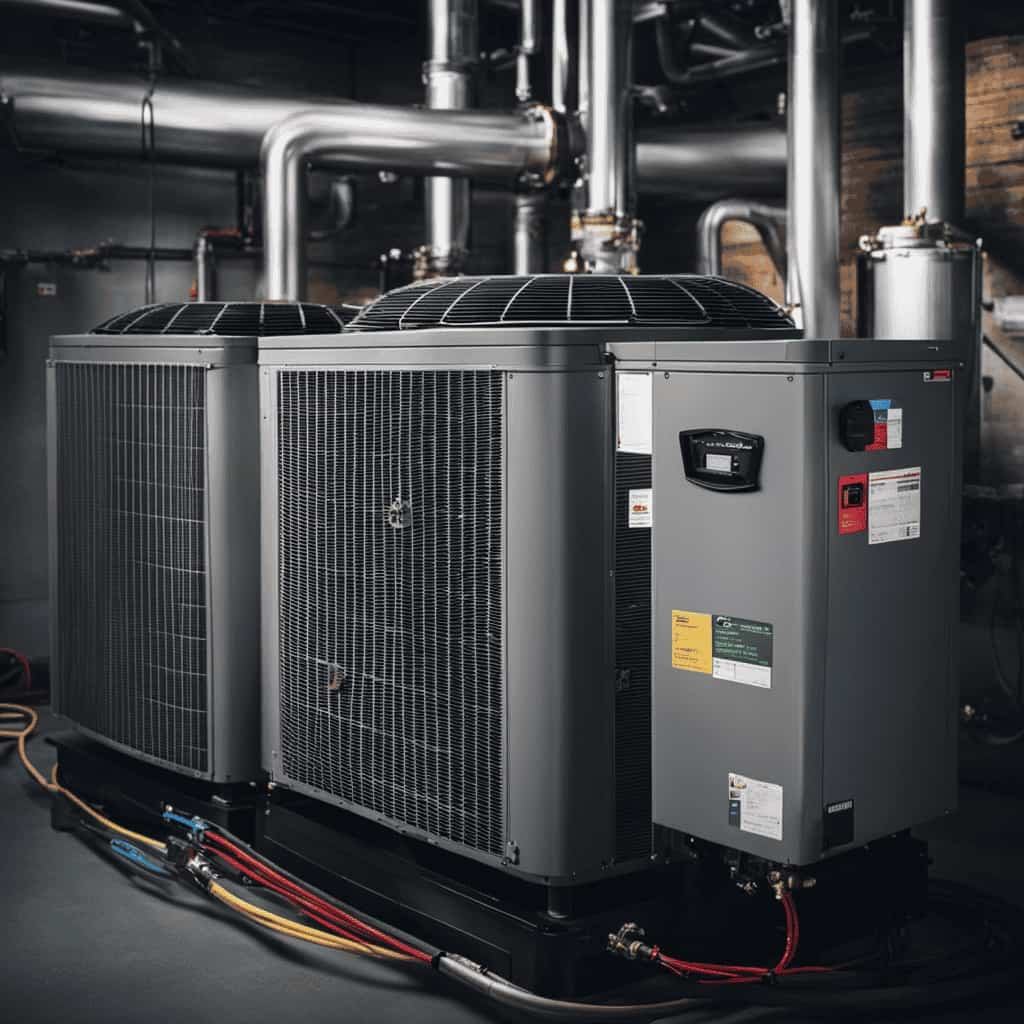
Are There Any Tax Credits or Rebates Available for Purchasing and Installing a Heat Pump?
Yes, there are tax credits and rebates available for purchasing and installing a heat pump. These incentives promote energy efficiency and can provide significant cost savings.
What Kind of Maintenance Does a Heat Pump Require, and How Often Should It Be Performed?
Heat pump maintenance is essential for optimal performance. Regularly cleaning or replacing air filters, inspecting outdoor unit coils, and checking refrigerant levels are necessary. It should be done annually to ensure efficient operation and prolong the lifespan of the heat pump.
Are Heat Pumps Included in the HVAC System?
When considering an HVAC system, one should not overlook the importance of picking the ideal heat pump. Heat pumps are indeed included in most HVAC systems as they efficiently provide both heating and cooling functions. With their ability to transfer heat from one area to another, heat pumps play a crucial role in maintaining desired indoor temperatures throughout the year.
Conclusion
After considering key factors such as efficiency ratings, sizing, and features, it becomes clear that selecting the perfect HVAC heat pump requires careful research and analysis.
The truth is that investing time and effort into understanding the options available can lead to significant energy savings and a more comfortable living environment.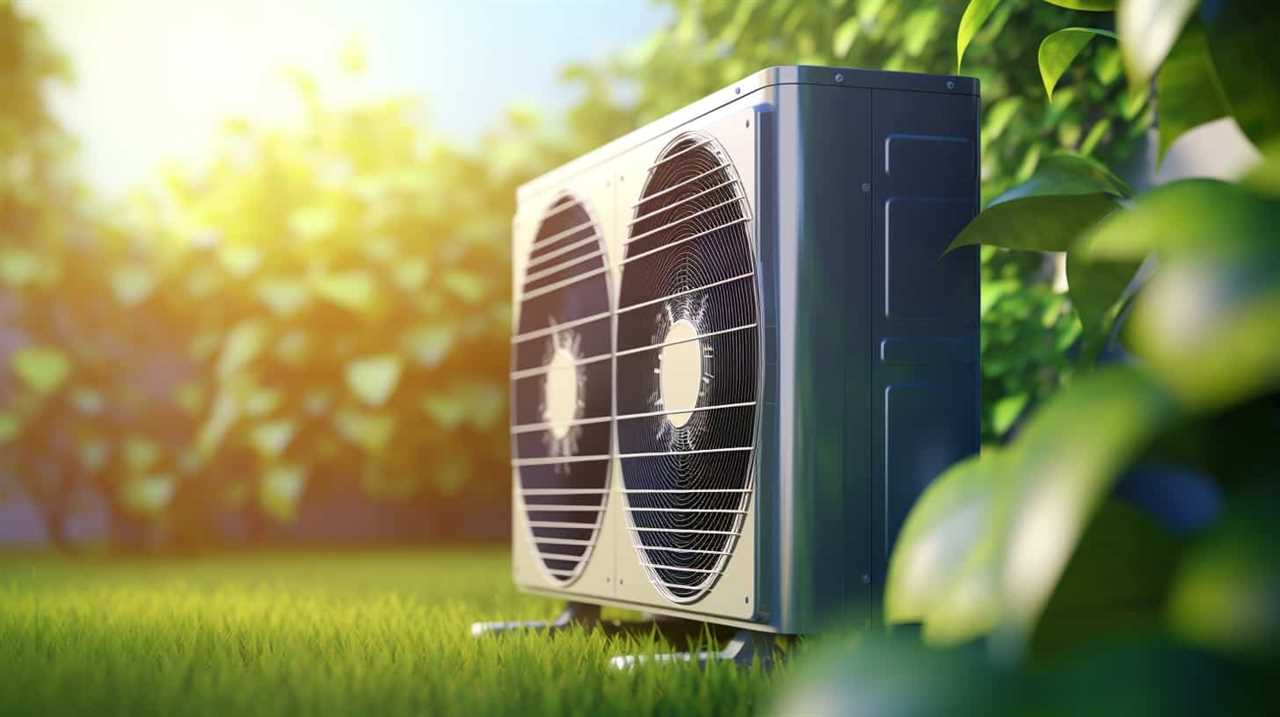
So, don’t hesitate to explore different types of heat pumps and evaluate installation and maintenance requirements to make an informed decision that meets your specific needs.
HVAC Systems
Unveiling High-Quality HVAC Systems With Heat Pumps

We thought we knew everything there was to know about HVAC systems with heat pumps. However, we were completely wrong.
In this eye-opening article, we’ll reveal the secrets of high-quality HVAC systems with heat pumps, uncovering the impressive features and energy-saving benefits that will leave you wondering why you didn’t upgrade sooner.
From efficiency ratings to troubleshooting tips, we’ve got you covered.
Get ready to be blown away by the innovative technologies and performance of modern HVAC systems with heat pumps.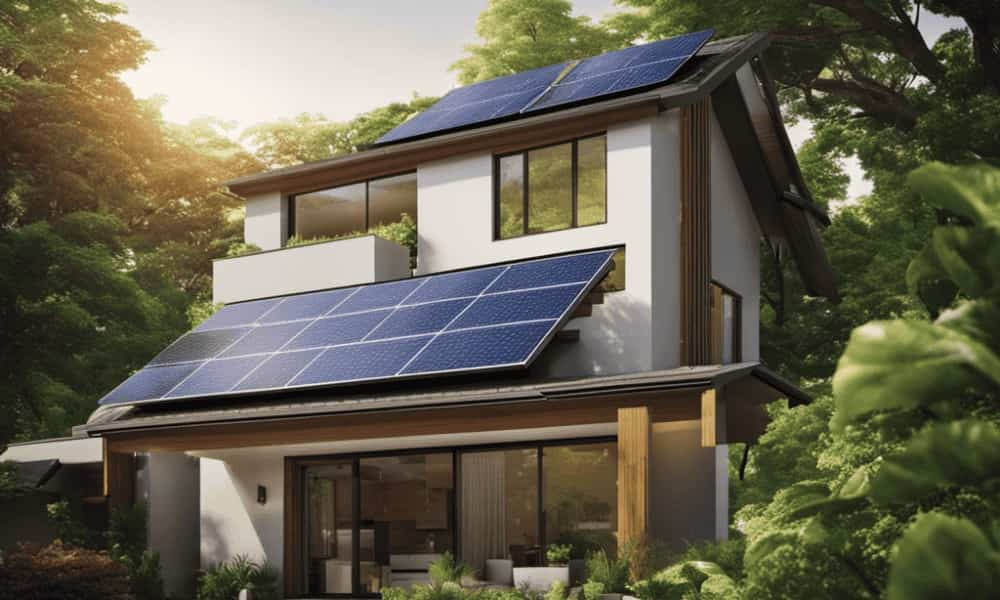
Let’s dive in.
Key Takeaways
- High-quality HVAC systems with heat pumps offer energy efficient technology that reduces energy consumption and saves money on bills.
- These systems use advanced sensors to detect temperature changes and adjust for optimal comfort.
- Variable speed motors enhance energy efficiency by operating at different speeds.
- HVAC systems with heat pumps provide effective heating and cooling without compromising performance, offering both comfort and energy savings.
Key Features of High-Quality HVAC Systems With Heat Pumps
Our high-quality HVAC systems with heat pumps offer key features that enhance energy efficiency and provide optimal comfort. With our energy efficient technology, we’ve designed our systems to consume less energy while still ensuring effective heating and cooling. This not only reduces your carbon footprint, but also saves you money on your energy bills.
Our cost effective solutions are designed to provide maximum comfort without compromising on performance. Our HVAC systems are equipped with advanced sensors that detect changes in temperature and adjust accordingly, ensuring that your home or office always stays at the desired temperature. Additionally, our systems use variable speed motors, allowing them to operate at different speeds depending on the heating or cooling needs, further enhancing energy efficiency.
With our high-quality HVAC systems with heat pumps, you can enjoy both comfort and energy savings.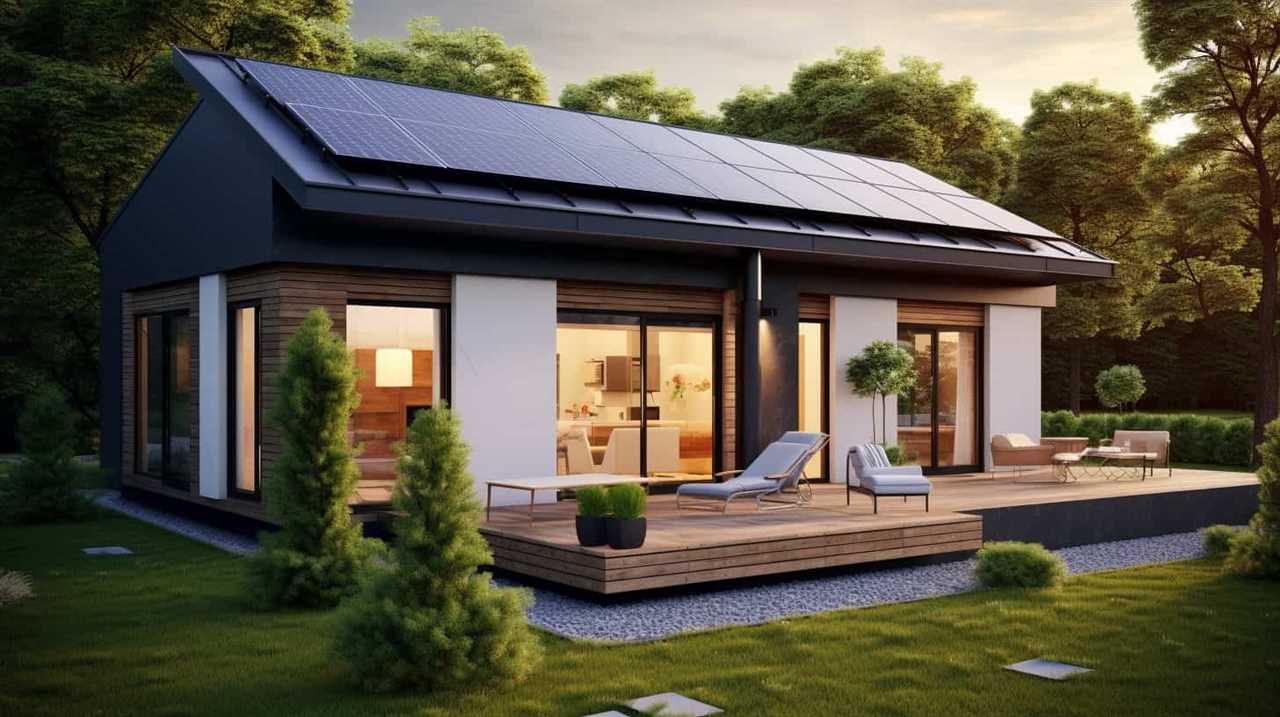
Benefits of Investing in Top Rated HVAC Systems With Heat Pumps
Investing in top rated HVAC systems with heat pumps offers numerous benefits, including increased energy efficiency and improved indoor air quality. These systems utilize energy efficient technology to provide cost effective solutions for heating and cooling needs.
Here are three key benefits of investing in top rated HVAC systems with heat pumps:
Energy Efficiency: HVAC systems with heat pumps use advanced technology to transfer heat from the air or ground, reducing the need for traditional heating and cooling methods. This results in lower energy consumption and reduced utility bills.
Improved Indoor Air Quality: HVAC systems with heat pumps not only regulate temperature but also filter and purify the air, removing pollutants, allergens, and odors. This leads to a healthier and more comfortable indoor environment.

Reduced Environmental Impact: By using energy efficient technology, top rated HVAC systems with heat pumps help reduce greenhouse gas emissions, contributing to a greener and more sustainable future.
Understanding the efficiency ratings of HVAC systems with heat pumps will further enhance your knowledge of their benefits.
Understanding the Efficiency Ratings of HVAC Systems With Heat Pumps
We should first understand the efficiency ratings of HVAC systems with heat pumps to make informed decisions about their energy-saving potential. Efficiency ratings indicate how well a system converts energy into useful heating or cooling, and are measured by two key metrics: Seasonal Energy Efficiency Ratio (SEER) and Heating Seasonal Performance Factor (HSPF). SEER measures the cooling efficiency of the system, while HSPF measures the heating efficiency. Both ratings are represented by a numerical value, with higher numbers indicating higher efficiency.
When comparing different HVAC systems with heat pumps, it’s important to look for higher SEER and HSPF ratings, as this will result in lower energy consumption and reduced utility bills. Understanding the efficiency ratings of HVAC systems with heat pumps allows us to evaluate their energy-saving potential and choose the most efficient option for our needs.

Now, let’s transition into the next section where we’ll explore different types of heat pumps for HVAC systems.
Exploring Different Types of Heat Pumps for HVAC Systems
When considering HVAC systems with heat pumps, it’s important to explore the different types available in order to make an informed decision. Here are three types of heat pumps commonly used in HVAC systems:
Geothermal Heat Pumps: These systems utilize the stable temperature of the earth to provide heating and cooling. They extract heat from the ground during winter and transfer heat into the ground during summer. Geothermal heat pumps are highly efficient and can significantly reduce energy consumption.
Air Source Heat Pumps: These systems extract heat from the outdoor air and transfer it indoors during winter, and vice versa during summer. They’re more affordable and easier to install compared to geothermal heat pumps. However, their efficiency may be affected by extreme temperatures.
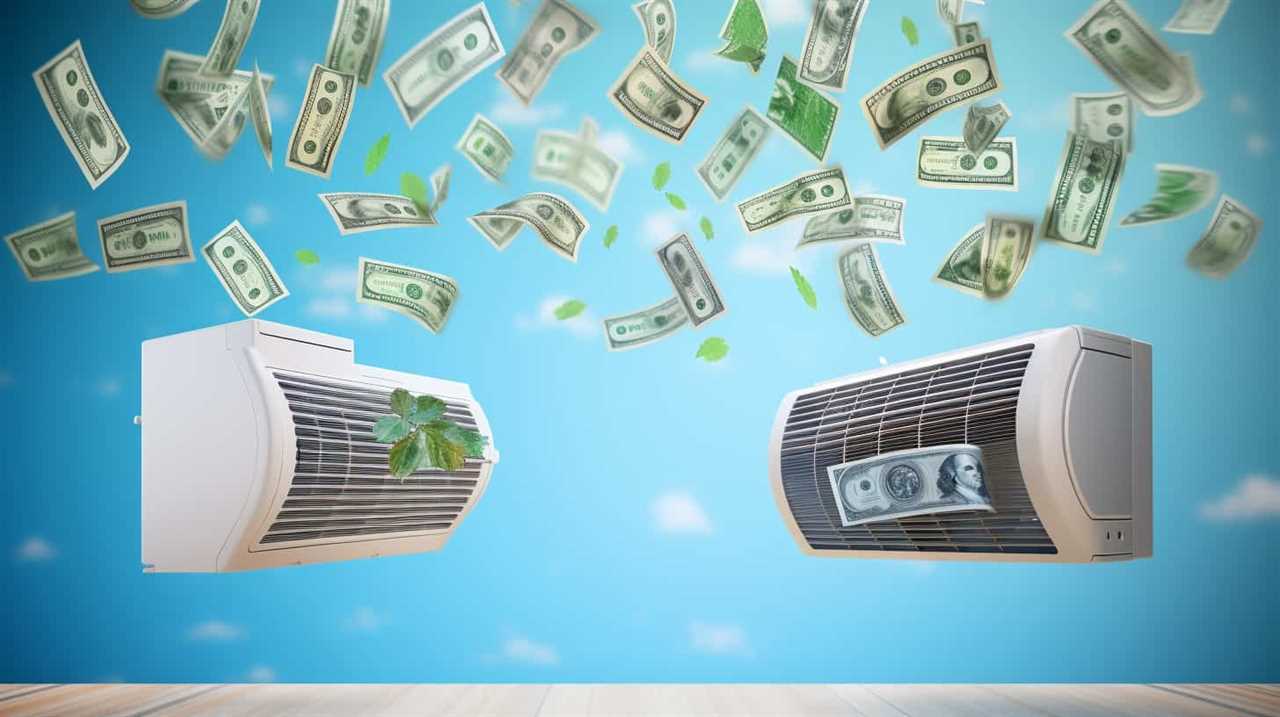
Hybrid Heat Pumps: These innovative systems combine the efficiency of geothermal heat pumps with the versatility of air source heat pumps. They automatically switch between the two heat sources based on outdoor conditions, maximizing efficiency and comfort.
Factors to Consider When Choosing a High-Quality HVAC System With Heat Pump
One important factor to consider when choosing a high-quality HVAC system with a heat pump is the energy efficiency rating. Energy efficiency is crucial because it directly impacts the system’s operating costs and environmental impact.
When evaluating the energy efficiency of an HVAC system with a heat pump, it’s essential to look for a high Seasonal Energy Efficiency Ratio (SEER) and Heating Seasonal Performance Factor (HSPF) rating. The SEER measures the cooling efficiency, while the HSPF measures the heating efficiency of the system. A higher SEER and HSPF rating indicate a more energy-efficient system, which can result in lower energy bills and reduced carbon emissions.
Additionally, it’s important to consider the energy efficiency of the heat pump itself, as this will affect the overall efficiency of the system.
The Importance of Proper Sizing for HVAC Systems With Heat Pumps
Proper sizing is crucial for ensuring optimal performance and efficiency of HVAC systems with heat pumps. When it comes to HVAC systems, size matters. Here are three reasons why proper sizing is essential for these systems:
Efficiency: A properly sized HVAC system with a heat pump will operate at its peak efficiency. Undersized systems may struggle to meet the heating or cooling demands, leading to increased energy consumption and higher utility bills. Oversized systems, on the other hand, tend to cycle on and off frequently, wasting energy and reducing comfort.
Proper Installation: Properly sizing an HVAC system ensures that it’s installed correctly. This includes selecting the right equipment, ductwork, and controls. A system that’s too small or too large may require modifications to accommodate the size, compromising its performance and efficiency.
Energy Efficiency: Properly sized HVAC systems with heat pumps can significantly improve energy efficiency. By matching the system’s capacity to the heating and cooling needs of the space, it can efficiently maintain a comfortable indoor environment while minimizing energy waste.

Tips for Maintaining and Extending the Lifespan of HVAC Systems With Heat Pumps
To ensure peak performance and longevity of our HVAC systems with heat pumps, it’s important to follow these tips for maintenance and extending their lifespan.
Regular maintenance is crucial for maintaining efficiency and preventing potential problems. Start by regularly cleaning or replacing air filters, as dirty filters can restrict airflow and reduce system efficiency. Additionally, clean the outdoor unit by removing any debris that could obstruct airflow. Inspect the refrigerant lines for leaks and ensure proper refrigerant levels. Lubricate the motor and other moving parts to reduce friction and wear. It’s also important to check and calibrate thermostats regularly to ensure accurate temperature control. Lastly, if any issues arise, troubleshoot problems promptly to prevent further damage.
By following these maintenance tips, you can maximize the lifespan and efficiency of your HVAC system with a heat pump.
Transition: Now that we’ve discussed the importance of maintaining and extending the lifespan of HVAC systems with heat pumps, let’s delve into the next section, where we’ll compare the performance of different HVAC systems with heat pumps.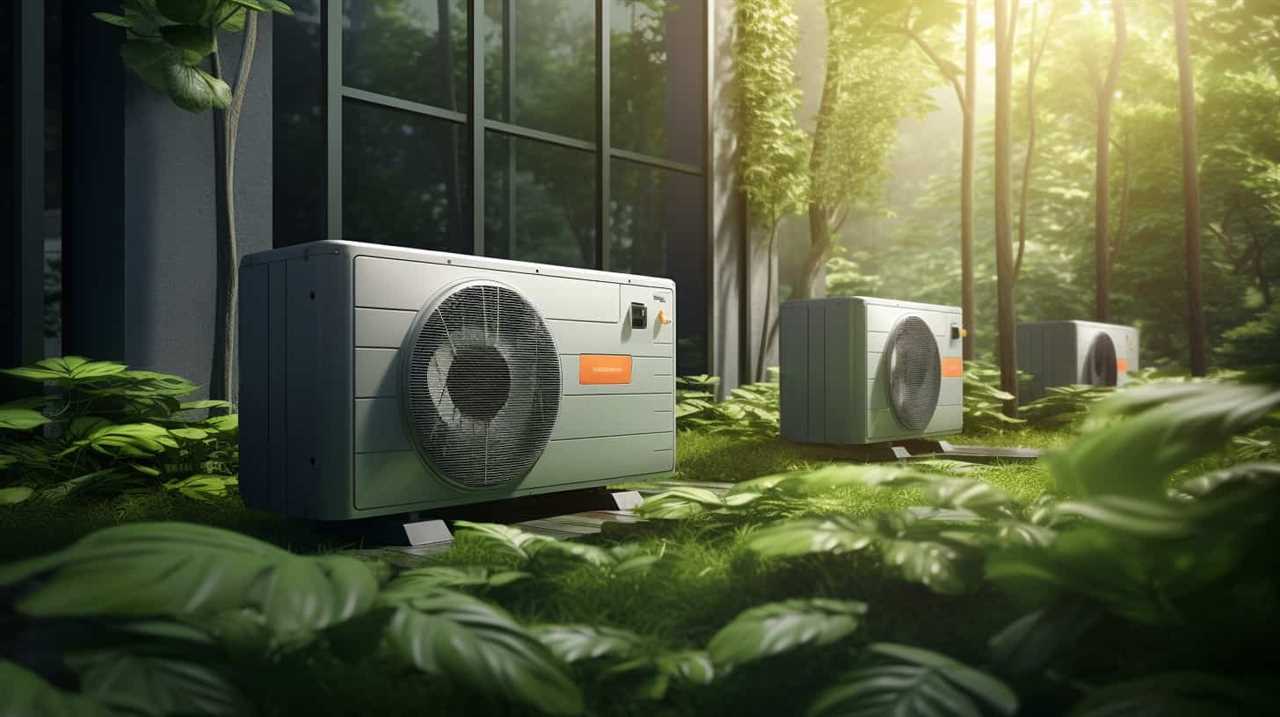
Comparing the Performance of Different HVAC Systems With Heat Pumps
When comparing the performance of different HVAC systems with heat pumps, we need to consider their energy efficiency, heating and cooling capacities, as well as their noise levels.
Here are three key factors to consider when comparing energy efficiency and cost effectiveness:
Seasonal Energy Efficiency Ratio (SEER): SEER measures the cooling efficiency of an HVAC system. The higher the SEER rating, the more energy-efficient the system is and the lower your cooling costs will be.
Heating Seasonal Performance Factor (HSPF): HSPF measures the heating efficiency of an HVAC system. Similar to SEER, a higher HSPF rating indicates better energy efficiency and lower heating costs.
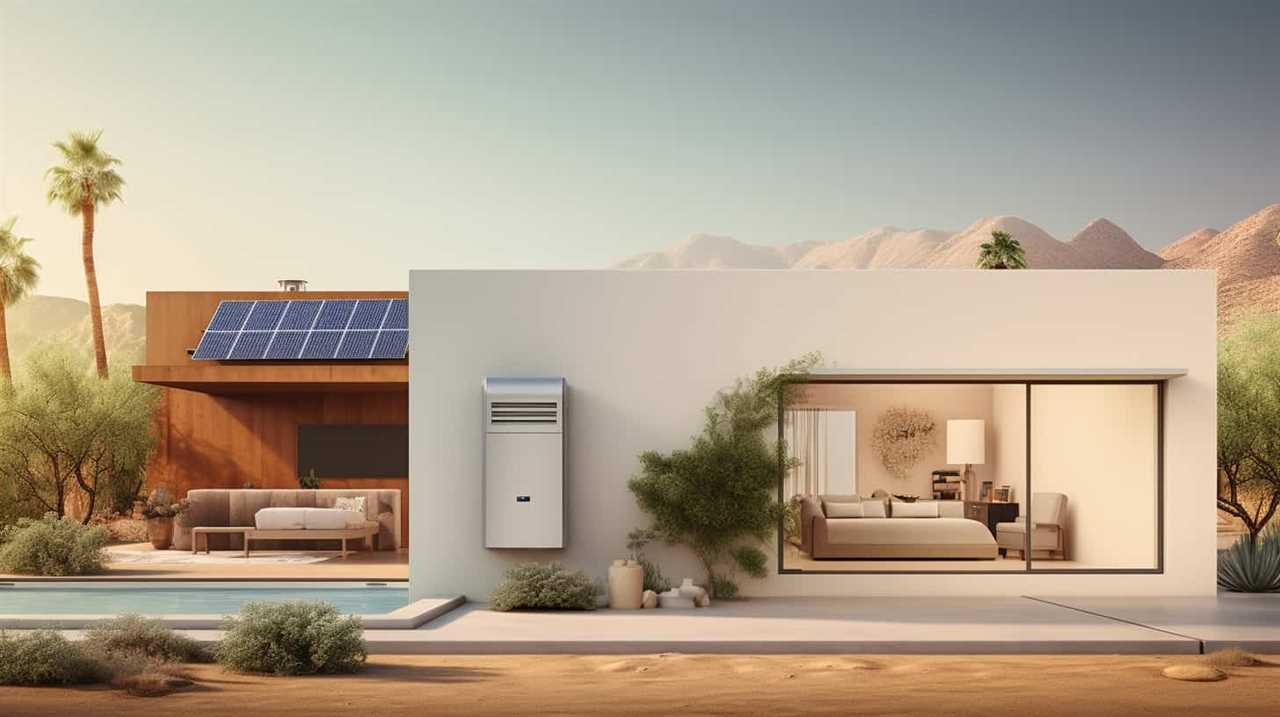
Coefficient of Performance (COP): COP is a measure of the heating or cooling output of an HVAC system divided by the energy input. A higher COP indicates better energy efficiency, resulting in lower energy costs.
Energy-Saving Features to Look for in High-Quality HVAC Systems With Heat Pumps
We frequently prioritize energy-saving features and actively seek out high-quality HVAC systems with heat pumps.
When it comes to energy efficiency, there are several key features to look for in a high-quality HVAC system. One important feature is the use of energy-efficient technology, such as variable-speed compressors and advanced control systems. These technologies allow the system to adjust its output based on the heating or cooling demands, resulting in reduced energy consumption and greater cost savings.
Another feature to consider is the use of smart thermostats, which can learn your habits and adjust the temperature accordingly, optimizing energy usage.
Additionally, high-quality insulation and well-sealed ductwork are essential for preventing energy loss and ensuring maximum efficiency.
Common Issues and Troubleshooting Tips for HVAC Systems With Heat Pumps
One of the most common issues that we encounter with HVAC systems with heat pumps is a loss of heating or cooling capacity. This can be caused by a variety of factors, including a malfunctioning compressor, refrigerant leakage, or a faulty thermostat.
To troubleshoot this issue, here are three common maintenance issues and troubleshooting techniques:
Check the air filters: Dirty or clogged air filters can restrict airflow and reduce the system’s efficiency. Regularly clean or replace the filters to ensure proper airflow.

Inspect the outdoor unit: Ensure that the outdoor unit is free from debris, such as leaves or dirt, that can obstruct the airflow. Clean the unit if necessary.
Verify proper refrigerant levels: Low refrigerant levels can affect the heat pump’s performance. If you suspect a refrigerant leak, contact a professional technician to locate and repair the leak before recharging the system.
Exploring Innovative Technologies in Modern HVAC Systems With Heat Pumps
Our article will now delve into the exciting realm of innovative technologies that are revolutionizing modern HVAC systems with heat pumps.
As the world becomes more aware of the importance of sustainability, exploring eco-friendly options in HVAC systems with heat pumps has become a top priority. Manufacturers are continuously developing new technologies that not only provide efficient heating and cooling but also reduce environmental impact.

One such advancement is the integration of smart technology into HVAC systems with heat pumps. These smart systems allow for remote control and monitoring, optimizing energy usage and providing real-time data on energy consumption. Additionally, smart technology enables the integration of renewable energy sources, such as solar panels, to power heat pumps, further reducing reliance on traditional energy sources.
Frequently Asked Questions
Can a High-Quality HVAC System With a Heat Pump Be Used in Both Residential and Commercial Buildings?
Yes, a high-quality HVAC system with a heat pump can be used in both residential and commercial buildings. The installation requirements may vary depending on the size and usage of the space.
Are There Any Government Incentives or Rebates Available for Investing in Top-Rated HVAC Systems With Heat Pumps?
Yes, there are government incentives and rebates available for investing in top-rated HVAC systems with heat pumps. These incentives aim to promote energy efficiency and provide financial support to encourage the adoption of high-quality HVAC systems.
How Do I Determine the Appropriate Size of an HVAC System With a Heat Pump for My Home or Building?
To determine the appropriate size of an HVAC system with a heat pump for our home or building, we should consider factors such as square footage, insulation, and climate conditions. Professional calculations and assessments can provide accurate recommendations.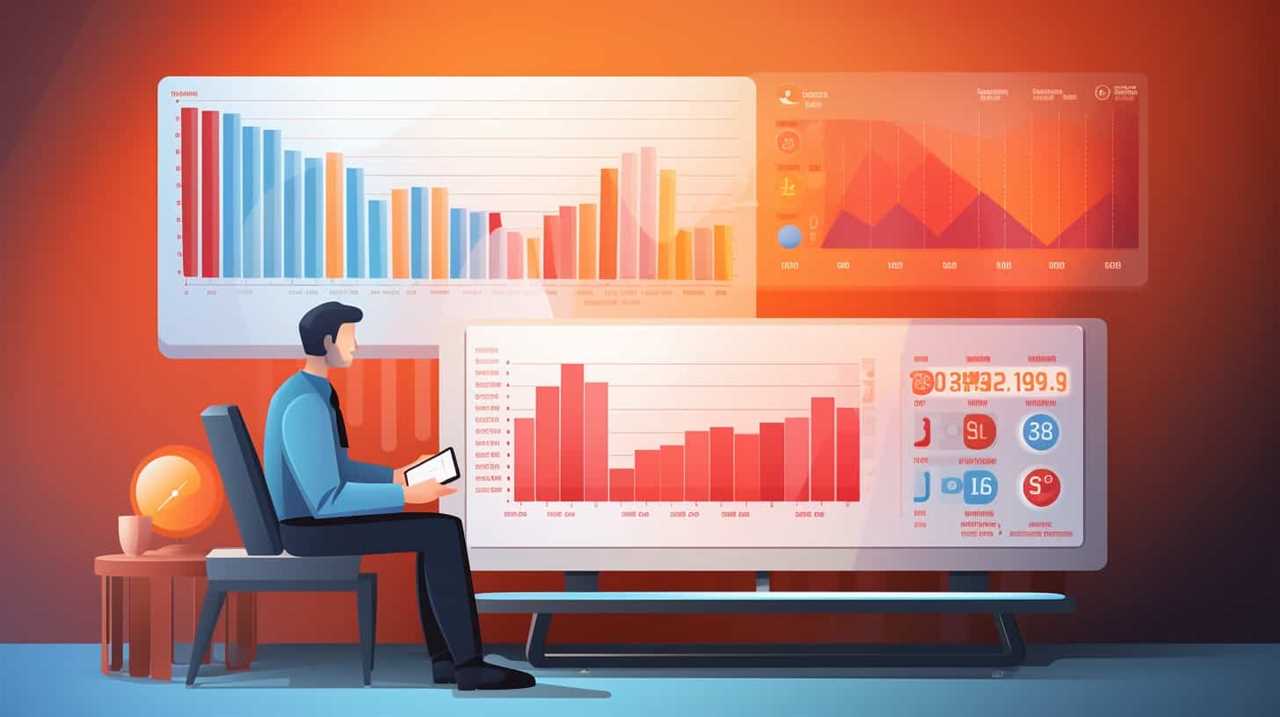
What Are Some Common Issues That Can Occur With HVAC Systems With Heat Pumps, and What Troubleshooting Tips Can You Provide?
Common issues with HVAC systems with heat pumps include airflow problems, refrigerant leaks, and thermostat malfunctions. To troubleshoot, check air filters, inspect refrigerant lines for leaks, and ensure the thermostat is set correctly.
What Innovative Technologies Are Being Used in Modern HVAC Systems With Heat Pumps, and How Do They Improve Efficiency and Performance?
Inverter technology and smart thermostats are two key innovative technologies used in modern HVAC systems with heat pumps. They greatly improve efficiency and performance by allowing for precise control and adjustment of heating and cooling output.
What Are the Top-Rated HVAC Systems with Heat Pumps on the Market?
Looking for the best premium-rated hvac systems with heat pumps on the market? Look no further! We’ve compiled a list of the top-rated options currently available. These systems offer efficient heating and cooling, superb energy-saving features, and reliable performance. With advanced technology and innovative designs, you can trust these top-rated HVAC systems with heat pumps to keep your home comfortable all year long.
Conclusion
In conclusion, investing in high-quality HVAC systems with heat pumps is like having a superhero protecting your home’s comfort and energy efficiency. These systems offer a range of benefits, from efficient heating and cooling to energy-saving features.
By understanding the efficiency ratings and exploring different types of heat pumps, you can choose the perfect system for your needs. With innovative technologies and troubleshooting tips, these HVAC systems are the key to a comfortable and sustainable living space.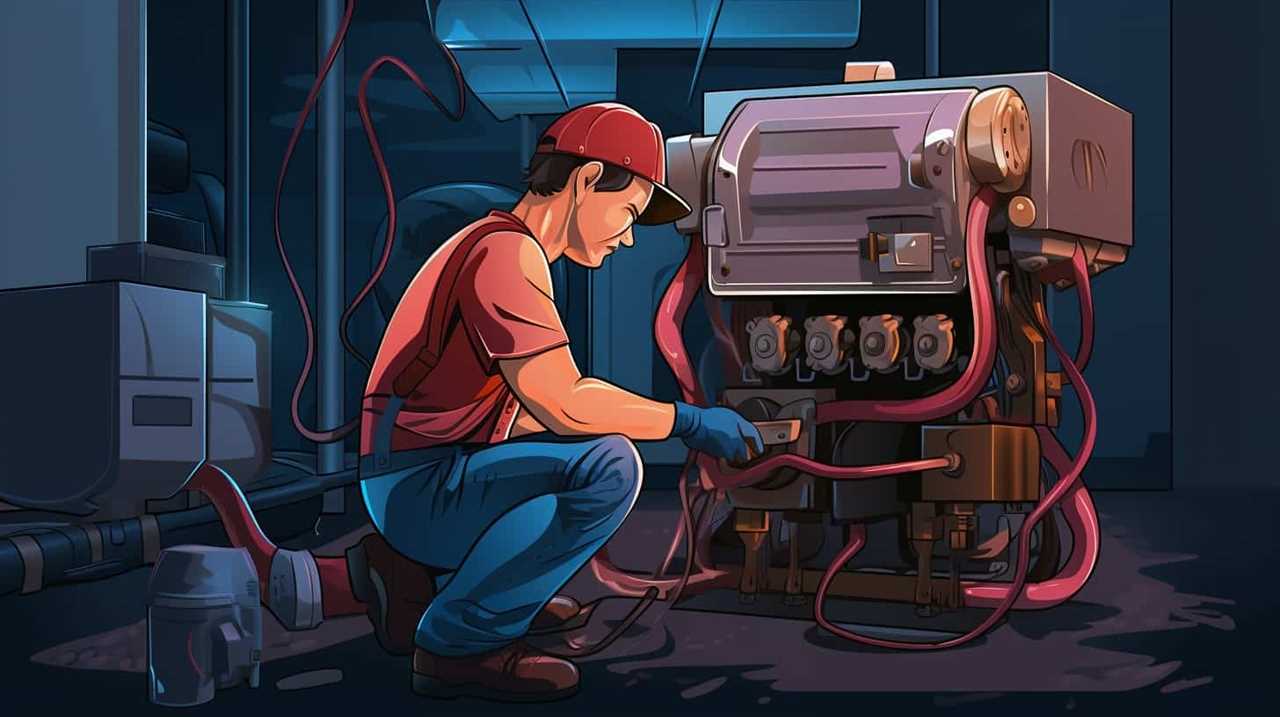
So, why settle for anything less than the best?
-

 Residential and Commercial Applications3 months ago
Residential and Commercial Applications3 months agoBest Amana Heat Pump Reviews
-

 Thermal Energy Transfer3 months ago
Thermal Energy Transfer3 months agoBreakthroughs in Modern Heat Pump Systems: Thermal Energy Edition
-

 Residential and Commercial Applications3 months ago
Residential and Commercial Applications3 months agoBest Heat Pump
-

 Geothermal Heat Pumps2 months ago
Geothermal Heat Pumps2 months agoUpgrade Your Comfort with Our Efficient HVAC Systems
-

 Geothermal Heat Pumps2 months ago
Geothermal Heat Pumps2 months agoInnovative Geothermal Heat Pump Manufacturers Revolutionize Energy Efficiency
-

 Air Conditioning4 weeks ago
Air Conditioning4 weeks agoExploring Energy-Efficient Air Conditioning Heat Pumps
-

 Thermal Energy Transfer3 months ago
Thermal Energy Transfer3 months agoBoost Your Heat Pump Efficiency: Interactive Guide
-

 Residential and Commercial Applications3 months ago
Residential and Commercial Applications3 months agoBest Portable Heat Pump Heat & AC











